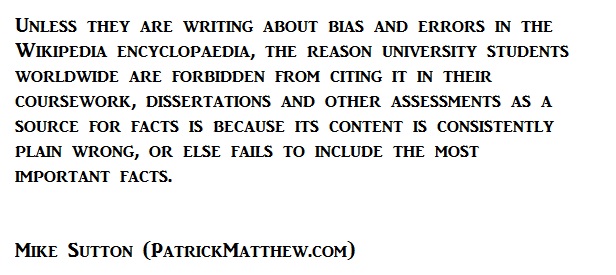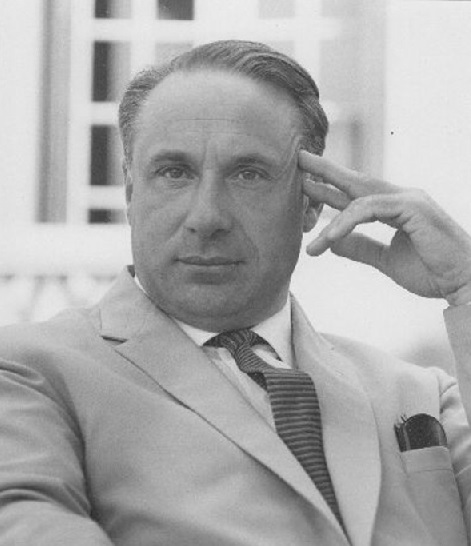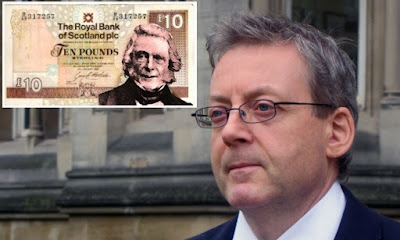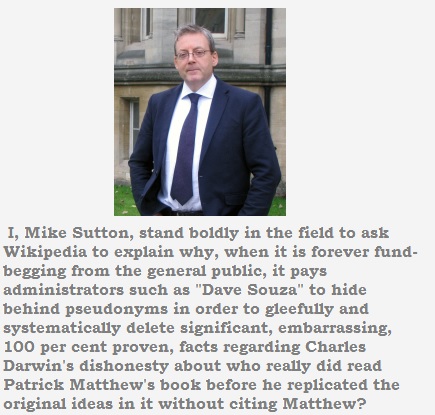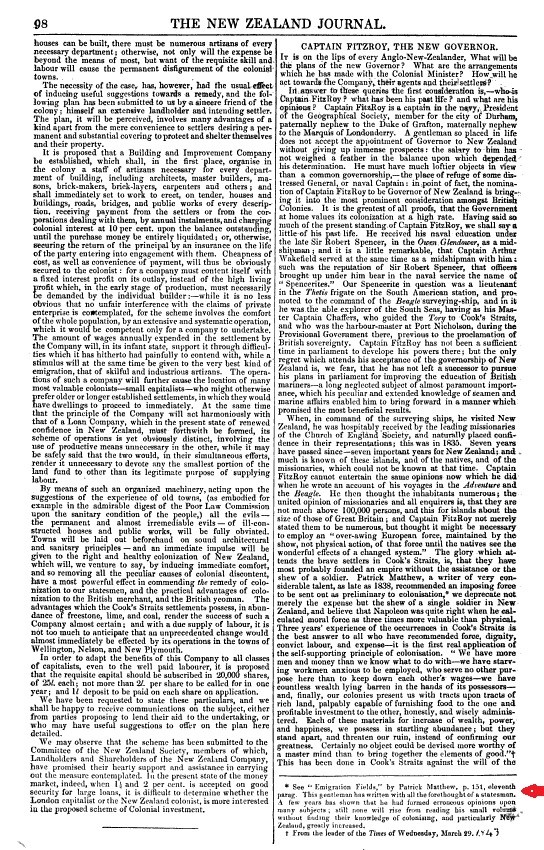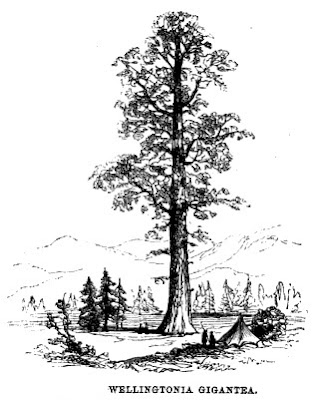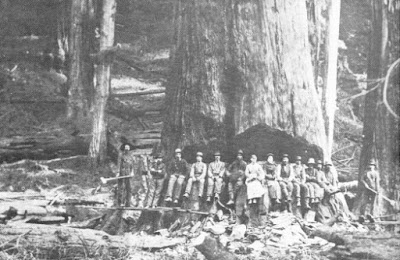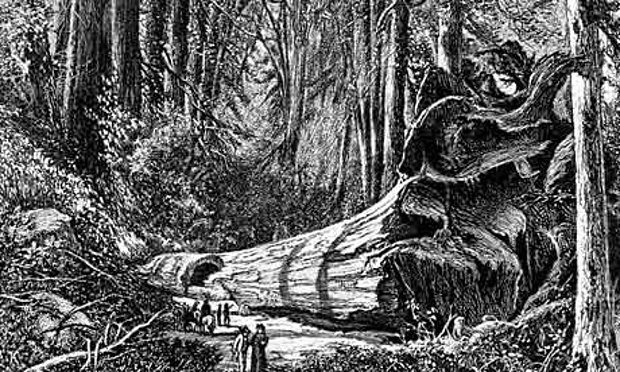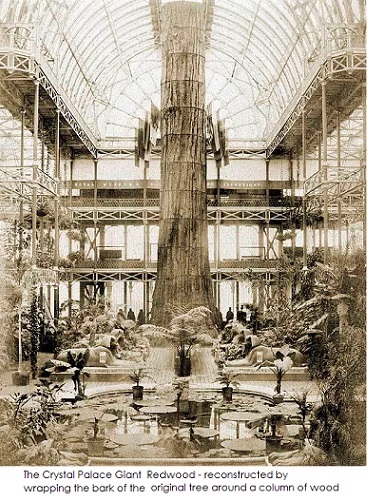Today the Scottish newspaper the Dundee Courier reports on the discovery of Charles Darwin’s plagiarism of Patrick Matthew’s prior-published discovery – and cites my BestThinking book that first broke the news to the World: Read the story in the Dundee Courier here .

Posts by MikeSutton:
- ‘Note that although the official publication date for the 7th Edition of the Encyclopaedia Britannica was 1842, in reality it was published in instalments starting in 1827. Volume 4 was available in bound form in 1832, which explains why all the books in the publishers’ advertising insert (“lately published by Adam Black, Edinburgh, and Longman, Rees, Orme, Brown and Green, London“) are from 1831-2 (for example, Memoirs of the Wernerian Natural History Society, Vol 6). Coincidentally, Volume 21 (the last volume, which really was published in 1842) contains a citation of Matthew’s book in its article on “Timber”. The advert is very similar to the Edinburgh Literary Journal (1831) advert, except the quotes from reviews have been updated. Even the aggressively negative review from the Edinburgh Literary Journal is quoted as a “Sample of Venom”, perhaps to pique the reader’s interest!”
- 2 at Gourdie Hill by Errol
- 2 at Mayquick Castle by Errol
- 2 at Ballendean by Inchture
- 1 at Kinnoul Nursery Perth
- 1 at Dr Lyall’s Newburgh Fife
- 1 at Balbirnie Fife
- 1 at Inchry House Fife
- 1 at Eglinton Castle Ayrshire
- July 1853 – Letter (dated) from John Matthew to his father Patrick Matthew uses the name Wellingtonia for the giant redwood he describes as growing in a swamp in California. This is (at least the time of writing Jan10th 2016) the first known use of the wordWellingtonia to name a giant redwood. We are told that with the letter arrived a packet of giant redwood seeds, which were the first to arrive in Britain. Patrick Matthew planted them. The trees that grew remain today as the Historic, Monumental Matthew Giant Redwood Trees in Scotland.
- December 1853 – in the Gardener’s Chronicle, John Lindley claims, fallaciously, that Lobb was the first person to introduce giant redwood seeds into Britain in December 1853 and that they were delivered personally to him by Lobb’s employer, Veitch. Having thereby established his historical position at the centre of things as a noted Botanist, Lindley then proposes the name Wellingtonia for the tree. Lindley cites no prior author in this naming proposal. The impression given is that it is entirely his own novel idea. To date (Jan 2016), the naming has always, fallaciously, been attributed in the literature to John Lindley.
- June 1854 – An extract of John Matthew’s July 1853 letter (accompanied by letter from Patrick Matthew) is published in the Gardener’s Chronicle. John Matthew’s letter names the giant redwood as “Wellingtonia” six moths before Lindley’s naming. Notably, at the time of writing, we don’t currently know when the Chronicle actually received the letter from Patrick Matthew with the extract from John Matthew’s 1853 letter. It may have been received as early as August 1853 or as late as May/June 1854.
- December 1866 – (a respectable year to the month after Lindley death in 1855) the Gardener’s Chronicle corrected Lindley’s fallacy that Lobb had priority for introducing giant redwoods into Britain and admitted that John and Patrick Matthew did so first and that Patrick matthew was first to plant the tree in Britain. No correction is made over the issue of who first named the tree Wellingtonia. Sutton (2016) was apparently the first to note this discrepancy – in the blog post you are currently reading.
- We do not 100 per cent know that Lindley was ever aware of “The July 1853 John Matthew ‘Wellingtonia’ Letter”. However, it is likely he would have known, since he was Editor of the Chronicle when the letter was published in 1854. If he did know about the letter what of the seeds? See next bullet point:
- John Matthew’s letter – may have been transcribed by Patrick Matthew for the Chronicle in whole or in part, or he may have sent them the original full letter. We cannot know. However, it is definitely presented by Matthew as transcribed in part, because he says so when he wrote that he includes an “extract”. We have no valid reason to doubt that Patrick was telling the truth about the published portion being merely an extract from a longer letter. The 1854 publication of the extract from John’s letter makes no mention in its published form of sending seeds to his father. We do not actually know, therefore, when – or how exactly – Patrick Matthew informed, and proved, to the Chronicle’s staff that he had received seeds in August 1853 from John Matthew. Patrick Matthew may have informed the Chronicle before Lindley’s article of December 1853. Or else, he may have informed them in June 1854. Or else, he may have informed them any time between August 1853 and June 1854. He may, for all we don’t know, have informed them at literally any time between his claimed receipt of the seeds in August 1853 and the 1866 Chronicle priority settling article in his and his son’s favour. However, the most likely scenario is that John Matthew’s full letter was furnished to the Chronicle at some time between August 1853 and June 1866, which is the proof the Chronicle had that John Matthew did include giant redwood seeds along with that letter, both of which arrived in his father’s hands, in Britain, in August 1853.
- What actually prompted the Gardeners’ Chronicle to investigate and settle the Matthew priority claim over Lobb in 1866?
- Did Patrick or John Matthew, or anyone else, lobby the Chronicle at any time from 1853 to 1866 to award priority to the John and Patrick Matthew in this matter?
- When did the Chronicle receive Patrick Matthew’s letter from his son dated July 1853? (let’s call it: “The July 1853 John Matthew ‘Wellingtonia’ Letter” ). Did Lindley (the Editor of the Chronicle) ever see the letter? If so, when?
- Did the Chronicle staff and/or Lindley receive “The July 1853 John Matthew ‘Wellingtonia’ Letter” before Lindley claimed that Lobb first brought the seeds into the country?
- If he did (and currently there is zero evidence he did), then – if Matthew informed the Chronicle between August 1853 and June 1854 about the seeds – Lindley would (being the Editor) most likely have known by June 1854 at the latest – that Matthew told the Chronicle he had received seeds from his son in August 1853, which is six months before Lindley claimed Lobb first introduced them into the UK and six months before he replicated the same name Wellingtonia that was in John Matthew’s letter!
- If it is the case that Lindley acted fraudulently in December 1853 over the Lobb priority and over his efforts at Wellingtonia naming priority, that would explain why the matter of Matthew’s priority was made public only 13 years after Patrick Matthew’s published extract of his son’s letter proved otherwise, and would explain why the matter of Matthew’s priority over Lobb was made public a precise 12 months after Lindley’s death. But more research is needed. The question of Lindley’s dishonesty in this matter remains suspicious but admittedly only reasonably speculative at the time of writing – based as it is on the currently available evidence.
- in 1860, Lobb and Lindley were celebrated in ‘Knights Pictorial Gallery of Arts’ because a mock-up of a huge Wellingtona was created for the world famous Crystal Palace Exhibition using the entire bark from a specimen (here);
- A lengthy, proprietorial and self-celebratory article in the Edinburgh New Philosophical Journal by Lindley (1860) (here).
- A lengthy article by Andrew Murray (1858) in the Transactions and Proceedings of the Botanical Society of Edinburgh (here).
- 1674 J. Josselyn Acct. Two Voy. 214 Towards night I returned to Boston again, the next day being Thanksgiving day, on Friday the Tenth day we weighed Anchor.
- 1704 N. Luttrell Diary in Brief Hist. Relation State Affairs (1857) V. 460 Sir Christopher Wrenn is erecting a throne in St. Pauls cathedral for her majestie to sittin on the thanksgiving day.
- 1714 S. Sewall Diary 25 Nov. (1973) II. 776 Thanks-giving day; very cold.
- 1844 J. G. Whittier Pumpkin iii, Ah! on Thanksgiving day..When the gray-haired New Englander sees round his board The old broken links of affection restored.
- Gunpowder Treason Day – 1630
- Gun-powder Treason Day – 1691
- Bonfire Night – 1705
- Gunpowder Day – 1768
- Firework Night – 1801
- Guy Fawkes Day – 1811
- Guy Fawkes Night 1832
- Gunpowder Night – 1854
- Gunpowder Treason Night – 1860
- Pope’s Night (USA ) – 1860
- Fireworks Night – 1865
Is Wikipedia Orwell’s 1984 Newspeak Dictionary?: A proof in the Spanish entry dedicated to Antidarwinism in 2009 and the evolution of this concept
April 12th, 2016
– A guest article presented by Mike Sutton –
The following article is written by Emilio Cervantes (IRNASA-CSIC. Salamanca Spain)
I was asked to assist in getting this information into the public domain so that it might be discussed by a wider audience. Doing so does not mean that I agree in any way whatsoever with its content, views or conclusions. Dr Mike Sutton
Emilio Cervantes
The following is an updated version of an article Published in the blog Biologia y Pensamiento in March 9, 2009.
The idea then proposed was that Wikipedia is the Newspeak Dictionary, predicted by Orwell in his novel 1984. This was supported by the facts related in 2009, and it is now confirmed by the changes done in the Wikipedia articles mentioned here (see at the end).
Don’t you see that the whole aim of Newspeak is to narrow the range of thought? In the end we shall make thoughtcrime literally impossible, because there will be no words in which to express it. Every concept that can ever be needed, will be expressed by exactly one word, with its meaning rigidly defined and all its subsidiary meanings rubbed out and forgotten. Already, in the Eleventh Edition, we’re not far from that point. But the process will still be continuing long after you and I are dead. Every year fewer and fewer words, and the range of consciousness always a little smaller. Even now, of course, there’s no reason or excuse for committing thoughtcrime. It’s merely a question of self-discipline, reality-control. But in the end there won’t be any need even for that. The Revolution will be complete when the language is perfect. Newspeak is Ingsoc and Ingsoc is Newspeak,’ he added with a sort of mystical satisfaction. ‘Has it ever occurred to you, Winston, that by the year 2050, at the very latest, not a single human being will be alive who could understand such a conversation as we are having now?
Orwell, 1984.
Might Wikipedia, the free and democratic encyclopedia, respond to an interest of indoctrination or manipulation? , could it include, between so much information, some with tendentious and manipulative intention in key questions? May we be confronting a wolf dressed with the skin of a lamb?
It seems that the answer to all these questions is going to be yes. That the popular and democratic encyclopaedia might contain here and there, between its entries, some written, corrected and supported, with the main intention of indoctrinating to the masses as propheticallly described Orwell in his novel 1984.
From some time now we find certain similarity between Wikipedia and Orwell’s Newspeak Dictionary. Now and then, an example comes to confirm it, but before entering in the matter, let’s see some fingerprints of newspeak in so popular encyclopaedia. Months ago we saw that the Wikipedia correctors, which are Darwinians, made a censorship to non-Darwinian interpretations of evolution. In the discussion of the article entitled “Biological evolution” this censorship was openly denounced by one of the participants:
(The hope that Wiki could be a source of neutral and plural information has been thrown to the bin. The hope that Internet could be a way of democratization of knowledge is being murdered in this site.)
Another example came when I wanted to include an article commenting on the book of Fernando Vallejo entitled La Tautología Darwinista “The Darwinian Tautology” and Varano (big lizard) erased it, indicating that the comment of the book was a literary critique.
Also it was surprising to verify then that the same authors who write the articles of Biological Evolution in Spanish are those writing on Creationism (in Spanish, creacionismo), supporting the thesis that Creationism is a Darwinian invention. In fact, the word Creationism first appears in Darwin and Huxley’s correspondence. But… Your attention please!: Faith or religion are not Darwinian inventions, … Creationism is. It departs from the basis that religious beliefs, opinions, or ideas can, in some moment, be confronted with scientific points of view. Something that was already discarded in the times of Galileo.
But there are more examples of manipulative zeal in Wikipedia. For example in the Spanish entry dedicated to Antidarwinism (2009).
The anonymous author, participant in the draft of other entries in Spanish related to education for the citizenship, the laic left, the European citizenship, the separation between Church and State, the Spanish exile in Mexico or the historical memory and others, almost all of them very far away from Science fields, dares he himself alone with Antidarwinism, a concept that would need a solid scientific formation not guaranteed in this author.
This way, the entry offers a notably antiscientific description. To such an end, once Antidarwinism was defined as the position opposite to Darwinism and therefore contrary to the general postulates of the theory of evolution by natural selection; then, instead of indicate which are such postulates and whether or not, they may admit perfectly opposite positions, we enter difficult areas. We continue reading:
Las posiciones antidarwinistas no son uniformes (se puede ser evolucionista pero no darwinista) y se apoyan en variados principios de la religión, el diseño inteligente, el creacionismo, el escepticismo, la magia, lo paranormal, la brujería, la ufología y otras pseudociencias de carácter sobrenatural
The antidarwinian positions are not uniform (it is possible to be an evolutionist but not Darwinist) and they are supported by diverse principles of religion, intelligent design, Creationism, skepticism, magics, paranormal, witchcraft, ufology and other pseudosciences of supernatural character
It is fascinating how fast Darwinian writers find a connexion between antidarwinism and witchcraft, ufology and other pseudosciences of supernatural character. It makes think that they are really worried by their own position close to all these aspects and situated in the middle of the pseudoscience.
But to these confusion we answered, when all this was still visible in 2009:
Not, anonymous author, you are wrong. The only lawful antidarwinism consists of a scientific position that denounces the deficiencies of the Darwinian postulates.
The scientific uselessness of those postulates that you did not want to indicate before but that anyone can read in Wikipedia’s corresponding entry consists in that they are full of mistakes. Therefore, please copy if you want to contribute to make this entry more precise:
Antidarwinism like a fully scientific position rests on two firm fundaments:
1- The poor scientific basis of the Darwinian postulates (Natural selection is a tautology).
2- The historical analysis of contemporary science discovers the predominance of social and economic interests on the scientific presentations and defense of Darwinism.
Everything else is in exceeds. Only serves to create confusion.
It ends here the article published in 2009. Now the entry dedicated to Antidarwinism has disappeared from Spanish Wikipedia and the reader is directed to Historia de las objeciones y críticas a la teoría de la evolución (History of the objections and critics to the evolutionary theory) where some of the Darwinist topics can be read again. For a page dedicated to objections and critics to the evolutionary theory it is surprising to find three illustrations: a phylogenetic tree and two images of Darwin. This demonstrating that even when we don’t want to read about Darwin we are obliged to, or… Do you remember?:
Every year fewer and fewer words, and the range of consciousness always a little smaller…
…‘Has it ever occurred to you, Winston, that by the year 2050, at the very latest, not a single human being will be alive who could understand such a conversation as we are having now?
Comments Off on Is Wikipedia Orwell’s 1984 Newspeak Dictionary?: A proof in the Spanish entry dedicated to Antidarwinism in 2009 and the evolution of this concept
Follow the Data: Wikipedia is being run by a weird cult called “Wikipedia Editors”
April 8th, 2016
– By Mike Sutton –
Readers of my research might know I have a rather long-term issue with the fact that a number of Wikipedia editors are actively and “tautologically” engaged in their own pseudo-scholarly personal agenda bias-driven campaigns to delete significant facts that do not fit those personal fact-deleting agendas. (e.g here and :here and here). And, best of the lot:Here.
A video caught in video
This video shows us one of these petty martinet-types being consensually caught in a video net of his own making. An aggrieved maker of his own YouTube video, which captures this Wikipedia editor’s video that depicts the “editor’s” apparently weirdly self-satisfied celebration of his undereducated, proudly inexpert, arrogant and illogical ne’erdowell self, is rightfully aggrieved in my opinion. The Wikipedia editor also reveals in his video that Wikipedia is effectively a weird cult with a labyrinthine set of unintuitive rules, which include – apparently – denying Americans their constitutional rights to assert their rights to seek redress when those rights are being denied.
Stick with the whole thing. You might need a stiff drink to endure it to the bitter end, but I think it is well worth watching and thinking about – for the next time you wonder why someone weirdly deleted your own significant and evidence-based veracious entry on a Wikipedia page.
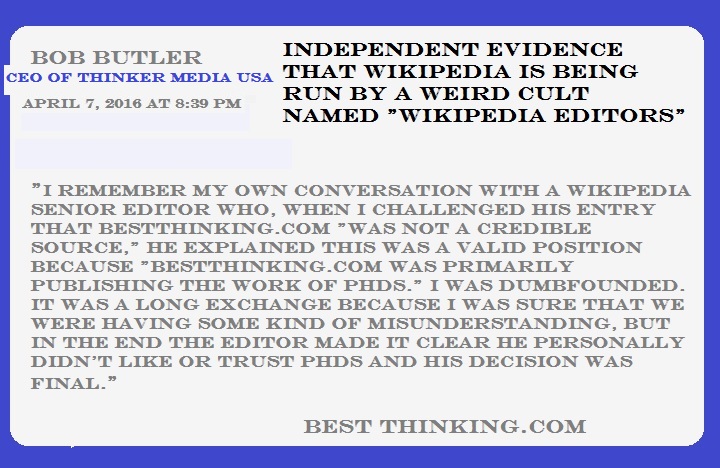
WARNING: In my opinion, this video of a Wikipedia, daft as a brush, woolly-headed, crack-pot who can’t think straight, editor, is toe-curlingly excruciating. Click to view it Here
The same aggrieved YouTube video maker “Gary” has more fact-based evidence ofWikipediapropaganda for us. WARNING: Gary asserts his constitutional right to use the obscene four letter female genitalia “C” word in his video. My link to it does not represent approval of such language to abuse others. In fact, my opinion is that I greatly disapprove of such language being used in such a way. But, just like Gary, I hate brute censorship based on mere opinions. So here it is. Right: Here
If you wish to see Gary’s website that Wikipedia editors deleted the Wikipedia link to. It is here .
Comments Off on Follow the Data: Wikipedia is being run by a weird cult called “Wikipedia Editors”
Human Organ Transplant Pioneer Despised Darwin’s Dishonesty
March 30th, 2016Darwinist muck-slinging began after Darwin capitulated to Matthew in the Gardener’s Chronicle of 1860
The image below was kindly sent to me by Jim Dempster’s daughter Soula Dempster. The red handwriting is her father’s. He annotated a copy of the historical sketch in Darwin’s Origin of Species, Dempster’s copy of the sketch is from the 1872 edition but its the same as that fistpubihed in 1861 from the third edition of the Origin onwards:
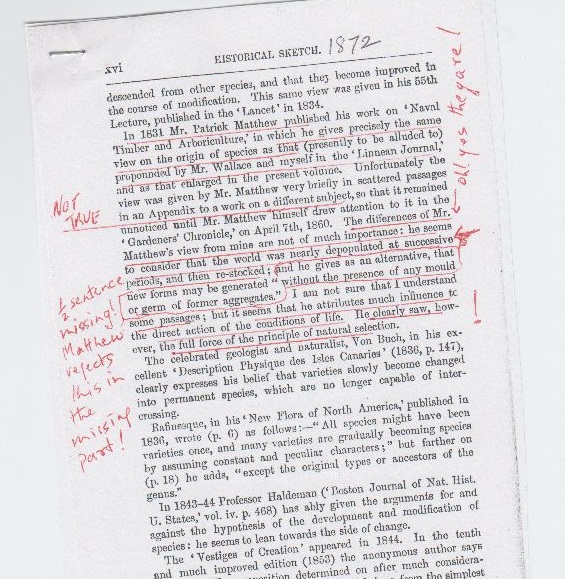 |
| Dempster’s notes on Darwin’s sly Deceptions in the Origin of Species |
 |
| Page 383 of Matthew (1831) ‘On Naval Timber and Arboriculture’ |
 |
| Matthew (1831) p. 381 |
Comments Off on Human Organ Transplant Pioneer Despised Darwin’s Dishonesty
Uncomfortable New Facts Discovered With Google Cause Upset
March 23rd, 2016Comments Off on Uncomfortable New Facts Discovered With Google Cause Upset
Why the Dundee Courier is the ideal newspaper to print the truth about Patrick Matthew and Charles Darwin
March 15th, 2016– By Mike Sutton –
Comments Off on Why the Dundee Courier is the ideal newspaper to print the truth about Patrick Matthew and Charles Darwin
Canny Failure of the English to Engage with the New Data Amounts to Anti-Scottish Discrimination in Science
March 13th, 2016– By Mike Sutton –
Building on the New Data first revealed in my Best Thinking book, Nullius in Verba and further ideas first formulated in a Best Thinking blog post in Jan 2015, my very latest peer reviewed journal article was published on the topic yesterday.
On Knowledge Contamination: New Data Challenges Claims of Darwin’s and Wallace’s Independent Conceptions of Matthew’s Prior-Published Hypothesis. Here.
In this new article, in the philosophy of science journal: Philosophy Aspects of Origin, I prove, amongst many other things, that rather than prove his independent conception of Matthew’s original ideas and examples, Darwin’s private correspondence, notebooks and private essays all serve to incriminate him as a lying plagiarizing science fraudster by glory theft of Patrick Matthew’s prior published hypothesis of the “natural process of selection”.
I am presenting this paper on thursday 17th March 2016, next week, at the James Hutton Institute in Scotland. Details here.
My hammering conclusion – which is to be reported in the Scottish press next week – is that Scotland has been punterized by 155 years of English lies, fallacies and myths that underpin the current paradigm of Darwin’s and Wallace’s independent conceptions of Matthew’s prior-published hypothesis.
Scotland has an unrecognised science hero.
Matthew, like many influential and original thinking Scots, hailed from the fertile lands of the beautiful Carse of Gowrie.
Punterised by Darwin’s 100 per cent proven lies into believing Matthew is relatively insignificant in the story of the discovery of natural selection, the Scots demolished his manor house in the 1980s.
That act of unintentional cultural vandalism raised to the ground their opportunity to use it and its ancient orchards as a major heritage site for cultural and economic sustainability. However, Matthew’s monumental giant redwood trees remain in the area. Today, in the interests of economic and cultural sustainability, it is essential that Scotland places protection orders on these historic Matthew Trees.
Scots need to read the new data and weigh its significance for themselves.
Fiona Ross, chair of The Carse of Gowrie Sustainability Group which has organised next Thursday’s lecture informs Scotland that a dream of Matthew’s descendants would be to see his portrait on the back of a Scottish £10 note.
One day Scotland will have Patrick Matthew on the back of it’s £10 note.
Comments Off on Canny Failure of the English to Engage with the New Data Amounts to Anti-Scottish Discrimination in Science
Shocking Fact: Wikipedia Administrators in Disgraceful Revisionist Cover-up of Darwin’s Lies About Matthew
February 27th, 2016By Mike Sutton.
In this blog post, I stand boldly in the field to ask Wikipedia to explain why, when it is forever fund-begging form the general public, it pays administrators to hide behind pseudonyms to gleefully and systematically delete significant, embarrassing, 100 per cent proven, facts regarding Charles Darwin’s dishonesty about who really did read Patrick Matthew’s book before he replicated the original ideas in it without citing Matthew.
Unless they are writing about bias and errors in the Wikipedia encyclopaedia, the reason university students worldwide are forbidden from citing Wikipedia in their coursework, dissertations and other assessments as a source for facts is because its content is consistently plain wrong, or else fails to include the most important facts.
This blog post reveals the absolute proof that Wikipedia’s paid employees are dishonestly and systematically hiding from the wider public the 100 per cent verifiable fact that Charles Darwin lied about the readership of Patrick Matthew’s original conception of the theory of macroevolution by natural selection.
Anyone trying to put the facts – with references to their validity in the publication record – on Wikipedia will be blocked by its paid employees. As a money-making organization, Wikipedia is punterizing us all by fund-begging from the general public for its so called encyclopedia. The following sorry tale reveals all.
On September 7th 2015, here on my Best Thinking blog, I wrote:
I challenge anyone to get the biased Darwinist Wikipedia editors to allow them to include on the Wikipedia Patrick Matthew page the hard fact led 100 per cent proof that Darwin lied about the reality of who really did read Matthew’s book pre-1860. Try it. I double-Darwin- dare you!
The challenge was repeated on my Patrick Matthew blog under the title The Double-Darwin Dare
Yesterday, someone tried.Then they showed me what happened. I’m reliably informed that the entire incident has been filmed for a TV documentary on the subject of Wikipedia administrators engaging in systematic fact-deletion on particular hobby-horse topics to which they have assigned themselves custodians of public knowledge.
In this particular incident, a Wikipedia administrator calling themselves “Dave Souza” fact-deleted the independently verifiable knowledge that Charles Darwin is 100 per cent proven to have published falsehoods about the readership of Patrick Matthew’s original ideas before he and Wallace replicated them without citing Matthew.
On the Wikipedia Patrick Matthew page, references to Darwin’s actions were supported by my scholarly, peer reviewed British Society of Criminology journal article (Sutton 2014 ). On the “Revisions history” page of Wikipedia’s Patrick Matthew page, Souza excused his historical revisionist behaviour – whereby he deleted the recorded and referenced facts of Darwin’s behaviour – with the falsehood that my journal article is self-published!
When Souzas revisionist edits were reversed, a battle of deletion and undoing of his deletion ensued. In the “Revisions history” page, reasons were given for restoring the facts and Souza was informed in writing that he was publishing falsehoods on Wikipedia about my British Society of Criminology journal article. Only when Souza was informed in writing on the “Revisions history” page that his historical revisionist behaviour was actually being filmed for a TV documentary did he cease his fact-deleting behaviour!
At the time of writing (8.51 am GMT 25/02/2016), the real facts of Charles Darwin’s dishonesty have finally been allowed to stand on the Patrick Matthew page. However, readers might be interested to learn that Wikipedia has currently deleted its entire “Revision history” page for the Patrick Matthew page by three months back to November 2015!
I think it is pretty clear that they have something to hide, simply because because they’ve currently gone and hidden it!
The telling question now is: what will they do next with the Patrick Matthew page?
Rest assured dear readers, whatever it is, I’m reliably informed that it will be filmed in the public interest and then broadcast.
Wikipedia’s employment and empowerment of personal hobby-horse fact censoring petty martinet administrators such as Dave Souza is what makes it so untrustworthy.
Wikipedia is ultimately controlled and edited by its paid “hobby-horse” unqualified, biased and gleefully under-educated chip-shouldered administrators.
PLEASE NOTE: The facts that Wikipedia does not want you to know about Darwin’s lies about the pre-1858 readership of Matthew’s book can be found on my RationalWiki page on Patrick Matthew.
The text Dave Souza was systematically deleting before being ethically informed his activities were being filmed for a TV documentary on Wikipedia bias.
On Wikipedia’s Patrick Matthew Page :
‘However, there is no direct evidence that Darwin had read the book, and the fact that he wrote that he sent out for a copy after Matthew’s complaint, only if true, meant that he did not have a copy in his extensive library or access to it elsewhere. In subsequent editions of The Origin of Species, Darwin acknowledged Matthew’s earlier work, stating that Matthew “clearly saw…the full force of the principle of natural selection”. From 1860 onward, Matthew would claim credit for natural selection and even had calling cards printed with “Discoverer of the Principle of Natural Selection”. Significantly, new analysis of the literature has called Darwin’s legendary honesty into question. Sutton (2014) “[21] presents published evidence from Matthew’s and Darwin’s 1860 letters in the Gardener’s Chronicle that Darwin published a falsehood by claiming in the Gardener’s Chronicle and from the third edition of the Origin of Species onward that Matthew’s original ideas went unread, because Matthew had already informed Darwin in print in the Gardener’s Chronicle in 1860 that his original ideas on natural selection were read by the naturalist John Loudon, who reviewed his book in 1831, by an unnamed naturalist who feared pillory punishment if he were he to teach Matthew’s ideas on natural selection, and that his book was banned by the public Library of Perth, referred to by Matthew by its nickname in Scotland: “the Fair City”. Darwin’s citation after 1860, and his published fallacy that Matthew’s ideas went unread before 1860 has done little to garner recognition for Matthew, since he is still generally unknown.’
Please Note: Further details and updates on this sorry saga are available on the Patrick Matthew Blog
Postscript 11.29 am GMT 25/02/2016
At the time of writing, Wikipedia has, currently, restored the incriminating Wikipedia revision history page on Patrick Matthew. This is what it currently looks like:
Patrick Matthew: (Wikipedia) Revision history page
(cur | prev) 19:22, 24 February 2016 BiasMonitor (talk | contribs) . . (33,387 bytes) (+1,172) . . (This fact deletion session by Souza is being filmed for a TV documentary on Wikipedian editor bias. Undid revision 706690883 by Dave souza (talk)) (undo)
(cur | prev) 19:19, 24 February 2016 Dave souza (talk | contribs) . . (32,215 bytes) (-1,172) . . (Undid revision 706690259 by BiasMonitor (talk) nope, ungrammatical and its in the wrong paragraph: take it to talk, or try adding it to the Sutton claims) (undo)
(cur | prev) 19:15, 24 February 2016 BiasMonitor (talk | contribs) . . (33,387 bytes) (+1,172) . . (Souza is deleting significant verifiable facts from Sutton peer reviewed article. This serious and unwarranted verifiable fact deletion will be reported. Undid 706679280 by Dave souza (talk)) (undo)
(cur | prev) 18:45, 24 February 2016 BiasMonitor (talk | contribs) . . (32,215 bytes) (-1) . . (Souza writing fallacious excuses. He is fact deleting a information from Sutton peer reviewed article Extreme bis displayed. Vandalism of facts. Undid revision 706680142 by Dave souza (talk)) (undo)
(cur | prev) 18:42, 24 February 2016 BiasMonitor (talk | contribs) . . (32,216 bytes) (+1) . .(Sutton’s is a peer reviewed article not self published. Souza is seriously vandalising verified valid facts..Undid revision 706681665 by Dave souza (talk)) (undo)
(cur | prev) 18:13, 24 February 2016 Dave souza (talk | contribs) . . (32,215 bytes) (-1) . . (null edit: on review, better summary is that the edits were changing the response to Sutton’s views into a reiteration of his dubious claims, thus undue weight.) (undo)
(cur | prev) 18:02, 24 February 2016 Dave souza (talk | contribs) . . (32,216 bytes) (+1) . . (null edit to note removed undue weight to self published “big data analysis” which hasn’t gained credence from historians) (undo)
(cur | prev) 17:56, 24 February 2016 Dave souza (talk | contribs) . . (32,215 bytes) (-1,172) . . (imd) (undo)
(cur | prev) 16:00, 24 February 2016 Bustermythmonger (talk | contribs) m . . (33,387 bytes) (-1) . . (Deleted a stray inverted comma) (undo)
(cur | prev) 15:59, 24 February 2016 Bustermythmonger (talk | contribs) m . . (33,388 bytes) (0) . . (Corrected typo “form” to “from”. “From 160 onwards…”) (undo)
(cur | prev) 14:57, 24 February 2016 Bustermythmonger (talk | contribs) . . (33,388 bytes) (+1,173) . . (Added independently verifiable factual information with reference to peer reviewed journal article by Sutton that Darwin published fallacies in both the Gardener’s Chronicle and from the third edit of the Origin of Species onwards’) (undo)
(cur | prev) 03:59, 24 February 2016 Donner60 (talk | contribs) . . (32,215 bytes) (-65) . . (Reverted good faith edits by 71.219.41.70 (talk): Spoiled link. (TW)) (undo)
(cur | prev) 03:33, 24 February 2016 71.219.41.70 (talk) . . (32,280 bytes) (+65) . . (→Life) (undo)
(cur | prev) 00:16, 8 February 2016 KasparBot (talk | contribs) . . (32,215 bytes) (-233) . . (migrating Persondata to Wikidata, please help, see challenges for this article) (undo)
(cur | prev) 11:51, 28 January 2016 Magioladitis (talk | contribs) . . (32,448 bytes) (+3) . . (→Further reading: fix) (undo)
(cur | prev) 16:40, 27 January 2016 Bender235 (talk | contribs) m . . (32,445 bytes) (+1) . . (clean up; http->https (see this RfC) using AWB) (undo)
(cur | prev) 11:58, 1 January 2016 Dave souza (talk | contribs) . . (32,444 bytes) (+9) . . (→Later opinions: put in date sequence) (undo)
(cur | prev) 11:43, 1 January 2016 Dave souza (talk | contribs) . . (32,435 bytes) (-102) . . (→Later opinions: ce) (undo)
(cur | prev) 09:47, 1 January 2016 BG19bot (talk | contribs) m . . (32,537 bytes) (-123) . . (WP:CHECKWIKI error fix for #61. Punctuation goes before References. Do general fixes if a problem exists. – using AWB (11756)) (undo)
(cur | prev) 09:43, 1 January 2016 BiasMonitor (talk | contribs) . . (32,660 bytes) (+222) . . (→Later opinions) (undo)
(cur | prev) 21:16, 31 December 2015 Dave souza (talk | contribs) . . (32,438 bytes) (-599) . . (→Later opinions: remove unsourced and anachronistic speculation: CD had already written out his theory before Vestiges was published, and no nat selection in Vestiges) (undo)
(cur | prev) 19:52, 31 December 2015 BiasMonitor (talk | contribs) . . (33,037 bytes) (+212) . . (→Later opinions: added further text on Darwin’s relationships with those who had pre 1858 knowledge of the ideas in Matthew’s book – because they cited it.) (undo) (Tag: Visual edit)
(cur | prev) 19:44, 31 December 2015 BiasMonitor (talk | contribs) . . (32,825 bytes) (+171) . . (→Later opinions) (undo)
(cur | prev) 18:52, 31 December 2015 BiasMonitor (talk | contribs) m . . (32,654 bytes) (+18) . . (→Later opinions: improved grammar and punctuation of my entry.) (undo) (Tag: Visual edit)
(cur | prev) 18:48, 31 December 2015 BiasMonitor (talk | contribs) m . . (32,636 bytes) (-1) . . (→Later opinions: deleted a rogue punctuation mark in my text entry) (undo) (Tag: Visual edit)
(cur | prev) 18:46, 31 December 2015 BiasMonitor (talk | contribs) m . . (32,637 bytes) (-2) . . (→Later opinions: tidied up some grammar from my earlier entry) (undo) (Tag: Visual edit)
(cur | prev) 18:43, 31 December 2015 BiasMonitor (talk | contribs) m . . (32,639 bytes) (-1) . . (→Later opinions: deleted typo “>”) (undo) (Tag: Visual edit)
(cur | prev) 18:42, 31 December 2015 BiasMonitor (talk | contribs) . . (32,640 bytes) (+980) . . (→Later opinions: Added references in support.) (undo)
(cur | prev) 18:27, 31 December 2015 BiasMonitor (talk | contribs) . . (31,660 bytes) (+694) . . (added information about what Sutton originally discovered) (undo) (Tag: Visual edit)
(cur | prev) 02:57, 31 December 2015 Rjccumbria (talk | contribs) . . (30,966 bytes) (-170) . . (→Naval Timber: rejig to remove recent POVvy spin-edits and to give the defence the last word) (undo)
(cur | prev) 02:34, 31 December 2015 Rjccumbria (talk | contribs) . . (31,136 bytes) (-908) . . (→Life: remove duplication, depurple Slesvig-Holstein) (undo)
(cur | prev) 02:03, 31 December 2015 Rjccumbria (talk | contribs) . . (32,044 bytes) (-106) . . (rejig to undo series of recent POVvy edits) (undo)
(cur | prev) 01:38, 31 December 2015 Rjccumbria (talk | contribs) . . (32,150 bytes) (-53) . . (Undid revision 697484378 by 97.126.178.140 (talk) one of a series of POVvy edits by 97.126.178.140) (undo)
(cur | prev) 01:37, 31 December 2015 Rjccumbria (talk | contribs) . . (32,203 bytes) (-1) . . (Undid revision 697485068 by 97.126.178.140 (talk) added non-grammatical comma) (undo)
(cur | prev) 01:35, 31 December 2015 Rjccumbria (talk | contribs) . . (32,204 bytes) (-4) . . (Undid revision 697485675 by 97.126.178.140 (talk) added ‘and’ adds ambiguity) (undo)
(cur | prev) 01:32, 31 December 2015 Rjccumbria (talk | contribs) . . (32,208 bytes) (-10) . . (Undid revision 697489000 by 97.126.178.140 (talk) one of a series of POVvy edits by 97.126.178.140) (undo)
(cur | prev) 21:20, 30 December 2015 97.126.178.140 (talk) . . (32,218 bytes) (+10) . . (→Later opinions) (undo)
(cur | prev) 21:04, 30 December 2015 97.126.178.140 (talk) . . (32,208 bytes) (+8) . . (undo)
(cur | prev) 20:55, 30 December 2015 97.126.178.140 (talk) . . (32,200 bytes) (+4) . . (→Life) (undo)
(cur | prev) 20:51, 30 December 2015 97.126.178.140 (talk) . . (32,196 bytes) (+1) . . (undo)
(cur | prev) 20:47, 30 December 2015 97.126.178.140 (talk) . . (32,195 bytes) (+2) . . (undo)
(cur | prev) 20:46, 30 December 2015 97.126.178.140 (talk) . . (32,193 bytes) (+53) . . (undo)
(cur | prev) 20:42, 30 December 2015 97.126.178.140 (talk) . . (32,140 bytes) (+24) . . (undo)
(cur | prev) 20:38, 30 December 2015 97.126.178.140 (talk) . . (32,116 bytes) (+31) . . (undo)
(cur | prev) 20:36, 30 December 2015 97.126.178.140 (talk) . . (32,085 bytes) (+1) . . (undo)
(cur | prev) 20:35, 30 December 2015 97.126.178.140 (talk) . . (32,084 bytes) (+203) . . (undo)
(cur | prev) 21:44, 29 December 2015 75.162.120.34 (talk) . . (31,881 bytes) (0) . . (→Naval Timber) (undo)
(cur | prev) 21:40, 29 December 2015 75.162.120.34 (talk) . . (31,881 bytes) (-3) . . (→Naval Timber) (undo)
(cur | prev) 19:33, 29 December 2015 75.162.120.34 (talk) . . (31,884 bytes) (+10) . . (→Life) (undo)
(cur | prev) 19:24, 29 December 2015 75.162.120.34 (talk) . . (31,874 bytes) (+33) . . (→Later opinions) (undo)
Comments Off on Shocking Fact: Wikipedia Administrators in Disgraceful Revisionist Cover-up of Darwin’s Lies About Matthew
Encyclopaedia Britannica Forced by New Facts Discovered with Google to Re-Write Page on Patrick Matthew and Charles Darwin
February 24th, 2016By Mike Sutton.
daughter – Soula Dempster – the Encyclopaedia Britannica has entirely re-written its Patrick Matthew page to reflect many of the “real facts” as opposed to the old Darwinist “false facts” that Matthew’s original publication of the full hypothesis of macroevolution by natural slection was read by others before Darwin and Wallace replicated it without citing Matthew. Nevertheless, at the time of writing they do, unfortunately for veracity, continue with the old “Appendix Myth” and they fail to mention that Darwin’s and Wallace’s friend Professor John Lindley cheated Matthew – for 13 years – from his right to be proclaimed as the first to introduce and propagate much admired giant redwood trees into Britain.
Click to view the page in question.
Historically, this is an interesting development because in my book Nullius I originally revealed that Matthew’s (1831) book was advertised on 3/4 of a prominent page of Part 5, Volume 2 of the Encyclopedia Britannica 1842.
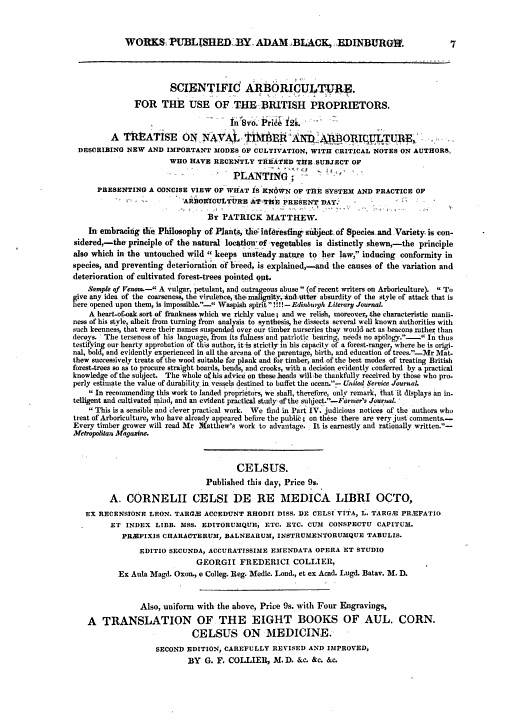 |
| An advert for Matthew’s (1831) book in the Encyclopaedia Britannica 1842
Significantly, the above advert had in fact been in the published literature since 1832 in the Encyclopaedia Britannica. Because, as Dr Mike Weale usefully points out on his Patrick Matthew Project website:
‘Note that although the official publication date for the 7th Edition of the Encyclopaedia Britannica was 1842, in reality it was published in instalments starting in 1827. Volume 4 was available in bound form in 1832, which explains why all the books in the publishers’ advertising insert (“lately published by Adam Black, Edinburgh, and Longman, Rees, Orme, Brown and Green, London“) are from 1831-2 (for example, Memoirs of the Wernerian Natural History Society, Vol 6). Coincidentally, Volume 21 (the last volume, which really was published in 1842) contains a citation of Matthew’s book in its article on “Timber”. The advert is very similar to the Edinburgh Literary Journal (1831) advert, except the quotes from reviews have been updated. Even the aggressively negative review from the Edinburgh Literary Journal is quoted as a “Sample of Venom”, perhaps to pique the reader’s interest!”
|
In 2015 Dr Mike Weale discovered an additional individual – who read Matthew’s book and cited it in the literature before Darwin and Wallace replicated the original ideas in it without citing Matthew – bringing the known total to 26. Weale writes on his Patrick Matthew Project website:
This brief citation is noteworthy for confirming that Matthew’s book was regarded as “valuable” by the author of the 1842 Encyclopaedia Britannica article on “Timber”. Note that Volume 21 really was published in 1842, unlike the other volumes which although they stated “1842” on their title pages were in reality published in earlier years. The article is signed “(B.Z.)”, identifiable as Augustin F. B. Creuze (1800-1852) via the Table of Signatures in Volume 1. Creuze also authored other articles for the Encyclopaedia Britannica, including a lengthy one on “Ship-building” that was published as a separate treatise, but Matthew is not cited in it. The article reproduces a table from Matthew’s book on the “number of concentric layers of sap-wood”. The citation is also noteworthy for making a reference to the “many things irrelevant to its subject” in the book. A similar opinion was expressed in the 1860 review of the book, likely by James Brown.
The following table of the number of concentric layers of sap-wood observed in various species of timber trees is extracted from a valuable work on Naval Timber by Patrick Matthew; a work which abounds in much sound practical information, though mixed up with many things irrelevant to its subject.’
More on the significance of what was written in the Encyclopedia Britannica advert for Matthew’s (1831) book can be read here.
Comments Off on Encyclopaedia Britannica Forced by New Facts Discovered with Google to Re-Write Page on Patrick Matthew and Charles Darwin
The Rifkin Imperative
February 11th, 2016By Mike Sutton.
Superhighway Robbery is a superb classic crime documentary, which is currently available for viewing on YouTube.

There are many lessons to be learned from the cases explored in this high quality TV programme about how offenders exploit new technology and how industry, governments and police services respond in a virtual arms race (See Sutton 2012).
Most importantly, in this superb documentary we can see evidence of a human characteristic that we might name the: “Rifkin Imperative“.
The story very early told in the documentary is that that despite Professor Stanley Mark Rifkin getting away with committing a $10 million computer fraud, and despite then laundering the stolen money successfully into “clean” diamonds, he just had to let someone know what he had done. Over the years, I’ve seen this apparent human characteristic lead to the detection of many serious offenders.
The “Rifkin Imperative” is essentially that many people – having gotten away with something they think defines them as very clever or very successful – feel that their clever deviant accomplishment is incomplete unless someone appreciates their greatness. After all, how can you feel complete as a “great and smart achiever” if no one in the world knows it was uniquely your personal great achievement?
More research is needed. For now, I think we should think of the “Rifkin Imperative” as a hypothesis in need of further criminological research. If confirmatory evidence is found for its universality, then law enforcement agencies – with a little lateral thinking – will know what to do when they have a suspect; or perhaps, even how to go fishing for one!
That said, my thinking here is far from original, because police officers are well aware of the potential for offenders to brag about serious crimes that they “got away with”. For example, we know from recent history the dangers of police honey traps, such as that used in theColin Stagg case , where Stagg was fingered as a likely offender by criminal profiling.
With Stagg in their sights, as the local weirdo, the Metropolitan Police sought out his criminal bragging to a murder. To be precise, they surreptitiously sought from Stagg – in exchange for the promise of sex with an attractive undercover police officer – a confessional bragging that he had committed the 1992 Wimbledon Common murder of Rachel Nickell.
But Stagg never bragged, because he never did it.
The case was thrown out in court and police officers involved in the Stagg Case were admonished by the judge for what they did. Nonetheless, and most convolutely, the “Rifkn Imperative” is actually confirmed in this case. The reason being, whilst Stagg was innocent, the real killer – Robert Napper – had years before he confessed to being Rachel Nickell’s killer – bragged to his mother in 1989 that he had raped a woman ! Police failed to follow up when Napper’s mother informed on him. Had they done so, then most surely, Rachel Nickell would not have been murdered and Colin Stagg would not have served 13 months in prison.
There will always be the problem to deal with of of those telling fantasy tales and feeling compelled to make false confessions.Meanwhile, to say it’s early days in the research process is a massive understatement. Nevertheless, the Colin Stagg case sets the current score at 1–0 for The Rifkin Imperative versus offender profiling.
Further Reading
More on Stanley Rifkin here .
More on Colin Stagg here
Comments Off on The Rifkin Imperative
Scotland: This Is Your Fight! End Darwin’s 155 Years of Punterization of All Our People
February 7th, 2016By Mike Sutton.
 |
| One day, Scotland will have Patrick Matthew on the back of it’s £10 note. |
So as not to face their significance, people may not fully engaged with dreadful facts. The range of denial devices used by those in a ‘state of denial’ include what Cohen (2001) terms ‘canny unresponsiveness’, ‘psychotic negation of manifest facts’, ‘lying to convince your listeners and reinforce your own denial of the real facts’, ‘negation by wishful-thinking’ ‘evasive reassurance that the facts are not that serious’, ‘victim blaming for their predicament’, ‘withdrawal of attention – deflecting the gaze’ and ‘compartmentalization’. These various manifestations of denial relieve the recipients of dreadful facts from immediate anxiety but, paradoxically, denial’s comforts create long-term dangers, against which we must remain alert.
The world’s leading evolutionary biologists admit that Matthew was first to publish the full hypothesis of macro evolution by natural selection. But scant attention has been paid to how Matthew’s right to be considered an immortal great thinker and influencer in science was stolen from him by the lies, fallacies and poor scholarship of Darwin and his Darwinists. Here is a list of just some of the tactics they employed:
1. Darwin’s and Wallace’s friend, John Lindley’s (1853) Matthew glory stealing giant redwood seeds bogus priority claiming fallacy.
2. Wallace’s replicating plagiarism of Matthew’s original conception and unique explanatory examples in his 1855 and 1858 papers.
3. Darwin’s (1858 and 1859) plagiarism and his Gardener’s Chronicle (1860) and Origin of Species (1861) glory theft lies.
4. Darwin’s friend, Professor David Anstead – or at the very least his anonymous editor weirdly added footnotes on his article – mockingly rubbishing Matthew in the Dublin University Magazine (January to June in 1860) effectively writing that he was an over opinionated crank who had written nothing original. The footnote can be read here. The Saturday Analyst and Leader (1860) then did the same thing.
5. In a gushing review of Darwin’s Origin of Species. Charles Dickens’s Magazine ‘All the Year Round’ (1860) quoted a paragraph of Matthew’s (1831) original prose yet never cited Matthew as its source. The uncited quote is to be found here.
6. The Dundee platform blocking of Matthew at the 1867 meeting of the British Association for Advancement of Science.
7. Royal Society Darwin Medal winners Ernst Mayr’s and Sir Gavin de Beer’s published glory stealing fallacies that the original ideas in Matthew’s book went completely unread/unread by any biologists – before Matthew brought them to Darwin’s attention in 1860.
8. Richard Dawkins’s pseudo-scholarly history and context free typical “state of denial” victim blaming of Matthew for what Darwin and his adoring Darwinists did to him.
DARWINIST DYSOLOGY
In addition to confirming the importance of understanding repeat victimization, their 100 per cent proven Darwinist fallacy spreading and dreadful pseudo-scholarly treatment of the facts confirms that the Dysology Hypothesis explains the Darwin Worship Industry’s biased history of the discovery of natural selection:
‘Letting scholars get away with publishing fallacies and myths signals to others the existence of topics where guardians of good scholarship might be less capable than elsewhere. Such dysology then serves as an allurement to poor scholars to disseminate existing myths and fallacies and to create and publish their own in these topic areas, which leads to a downward spiral of diminishing veracity on particular topics.’
Comments Off on Scotland: This Is Your Fight! End Darwin’s 155 Years of Punterization of All Our People
On Americanisms: Two Nations Divided by Different Meanings of the Same Language
January 31st, 2016
– By Mike Sutton –
In 1944 people started to attribute the phrase ‘England and America are two countries divided by a common language.’ to George Bernard Shaw (GBS). One problem is they never cited the source and another problem is I’ve found the earliest source of the phrase on Google, which attributes it to GBS – but its written by someone who I can’t identify. It’s on page 40 of American Affairs: The Economic Record, Volume 6.
“George Bernard Shaw was responsible, I believe for the observation that England and the United States are two nations divided by the same language”.
Whoever wrote it and attributed it to Shaw is perhaps actually the best bet we may ever have for the true originator of this popular phrase.
Perhaps there is another database with someone falsely attributing the quote to Shaw? Perhaps there we will discover an earlier source. If not, perhaps the name of our mystery author in question will be revealed. If anyone finds out please leave a comment over at my twinned blog site on Best Thinking
The website “Misquotes” informs us:
This supposed quotation doesn’t appear anywhere in the copious writing of GBS. A similar idea was expressed by Oscar Wilde in The Canterville Ghost, 1887, some years earlier than Shaw was supposed to have said it:
“We really have everything in common with America nowadays except, of course, language”.
I found something some 54 years earlier than Oscar Wilde’s prose on this theme. It’s onpage 448 the 1833 Penny Cyclopaedia of the Society for the Diffusion of Useful Knowledge in a discussion of the evolution of “Americanisms”:
“…we see a new phenomenon in the history of the world of two great nations separated by a wide ocean using the same language.”
The 1833 article in continues:
‘The mother country may yet claim, and perhaps her claim will be allowed by some Americans the privilege of a very rigid examination of American importations, before she allows them to be current coin of the realm; but to attempt to reject all new words that America produces would be both absurd and ineffectual. New wants and new circumstances are the parents of new terms, which perhaps, increase quicker there than in an old country. The main differences between the spoken and written English language as it exists in America and Great Britain appear to be the following pronunciation:- the use of words now obsolete in England or used in different senses.’
On which note, it rather amuses some of my English friends that our American cousins don’t realise that they have a political contender with apparently little sense and a rather silly name.
I think that Donald Trump has an odd squeezing look that matches his name.
The parenting site Netmums reveals all .
Comments Off on On Americanisms: Two Nations Divided by Different Meanings of the Same Language
On States of Denial
January 24th, 2016– By Mike Sutton –

The British ‘establishments’ of the BBC and Royal Society were in a ‘state of denial’ about the serious serial lying and other delinquent activities of celebrities Sir Jimmy Savile (OBE), Rolf Harris (CBE) and Charles Darwin(FRS). But it wasn’t just those august institutions that failed to see the facts. We all failed. Why were we all blindsighted by the facts? The answer is obvious in hindsight, and is explained perfectly by the psychological phenomenon of ‘denial’.
Savile, Harris and Darwin were all wealthy. All were considered to be pillars of society, highly moral and trustworthy ‘national treasures’. These positive attributes blinded society to the obvious and significant disconfirming facts of who they really were and what they actually got up to.
In all such cases where society has been in a ‘state of denial’ (Cohen 2001 ), someone is, eventually, able to break the negative hallucination (not seeing what is obviously and significantly there) to convince the world of the facts that “The king has no clothes!” It takes time to get through the stonewalling of protective ‘establishment’ interests and public adoration – but the facts pound like a battering ram against their denials, canny indifference and blindsight. Eventually, the wall caves-in and facts then rush through. And after the breech is made, the public wants to know why it took so long. Who, they demand, is to blame?
The recently released US film ‘Spotlight’ provides a perfect blow-by-blow account of how the Boston Globe reporters eventually overcame the US ‘state of denial’ over pedophile Catholic priests.
More detail about our ‘state of denial’ regarding Savile, Harris, Darwin, and pedophile Roman Catholic priests here.
Comments Off on On States of Denial
In a Terrible ‘State of Denial’: Revealing More Facts that are Seemingly Invisible to Darwin Scholars
January 22nd, 2016– By Dr Mike Sutton –
The Day the Supposedly Obscure Writer, Patrick Matthew’s Book “Emigration Fields” was Recommended Reading Material for Captain Fitzroy of the Beagle. No less!
The Year 1844. The publication:
The New Zealand Journal – Volume 4 – Page 98.
(See red arrow at bottom of second image below)
Charles Darwin – whilst penning a deliberate lie to a famous French biologist was later to refer to Matthew as merely an obscure writer on forest trees:
Letter from Darwin to Quatrefages de Bréau in his letter of April 25, 1861 Darwin lied:
“I have lately read M. Naudin’s paper; but it does not seem to me to anticipate me, as he does not shew how Selection could be applied under nature; but an obscure writer on Forest Trees, in 1830, in Scotland, most expressly & clearly anticipated my views—though he put the case so briefly, that no single person ever noticed the scattered passages in his book.”
Context of Darwin’s lie (here) .
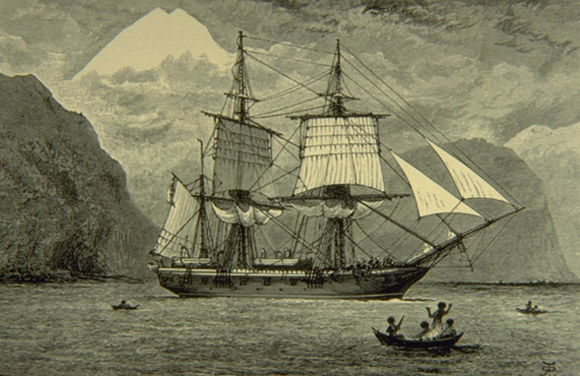
|
| The HMS Beagle: Captained by Ritzroy. The famous ship that took Darwin to the Galapagos islands, which – contrary to the Finches Beaks Myth – he left still believing a divine creator was responsible for the origin of species. |
Seventeen years before Darwin portrayed Matthew as an obscure writer and in the same year Darwin claimed to have written a mere private essay on natural selection, Patrick Matthew’s second book is recommended in the press to none other than the man for whom Charles Darwin was,employed to be expedition geologist and table companion for Captain Robert Fitzroy of the HMS Beagle.
Matthew’s (1839) book was recommended to Fitzroy following news of his appointment as Governor of New Zealand.
In his (1839) book ‘Emigration Fields’ – and contrary to Darwinist mythology that he never developed his ideas on natural selection after is origination of them 1831 – Matthew, in actual fact, took his original ideas on natural selection, and the importance of those ideas for propagating naval timber, and for addressing the artificial selection problems caused in human society, forward for the human species. Matthew did this in his 1839 book, in particular for the Anglo Saxon variety of human known generally as British. On the opening pages of his book Emigration fields, we see Matthew’s (1831) On Naval Timber and Arboriculture was promoted.
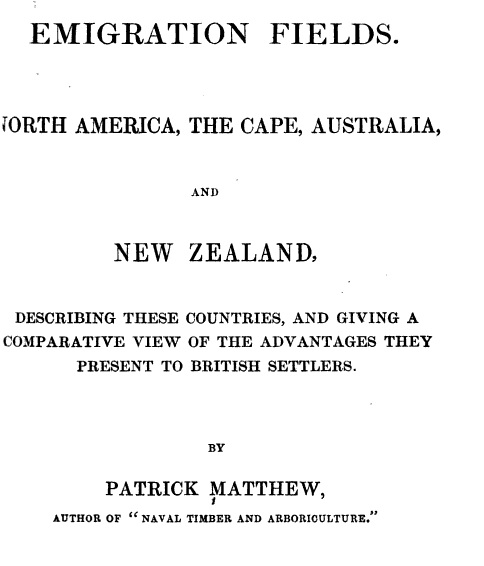
Darwin labelled Matthew an obscure writer on Forest Trees as part of the classic response process of those in a ‘state of denial’ of the uncomfortable facts. It’s known as ‘victim blaming’. That move was simply another of several sly Darwin-penned fallacies that were written to put others off the scent of the truth.
Darwin’s obscure writer on forest trees excuse, was greatly aided and abetted by the fallacies written by the botanist John Lindley (best friend of the father of Darwin’s best friend Joseph Hooker), which for 13 years concealed the fact that Patrick Matthew and his son John were the first to bring the greatly admired giant redwood tree seeds into Britain and propagate the trees in Scotland. Thanks to the fallacy spreading of the immensely powerfully connected Professor Lindley, he and Lobb received adoring credit by naturalists until the myth was bust by publication of the facts – but only a full year after Lindley’s death in 1865. Moreover, I uniquely and originally discovered in January 2016 that John Matthew named the trees Wellingtonia six months before Lindley is officially accredited with the botanical naming. Furthermore, I discovered that Lindley was in possession of an abstract of a letter (and possibly the whole letter) that disproved his and Lobb’s fallacious claim to Matthew’s glory as least six months after he made it, but possibly six months before!
In 1860, Charles Darwin created four fallacies about Matthew. Darwin scholars turned them into myths by blindly parroting those fallacies as the gospel truth. They parroted them as though they represent valid reasons why Darwin replicated Matthew’s original ideas, terminology and explanatory examples, 27 years after Matthew’s book was published, without citing their original published source.
Darwin claimed Matthew had no influence on him or anyone else. He supported that claim by writing the fallacy that no one read Matthew’s ideas before 1860. In reality, influential naturalists around Darwin, who influenced him on the topic of organic evolution, either read Matthew’s book and cited it (Chambers), or else read and cited it before then editing the work of those who influenced Darwin and Alfred Wallace (Selby and Loudon).
Darwin’s four fallacies about Matthew and his book: Blindly parroted by credulous Darwin scholars for 155 years as excuses for Darwin and Wallace not citing it.
1. The lie that Matthew buried all his ideas on natural selection in the appendix of his book. (See The Appendix Myth)
2. The lie that no naturalists / no one at all read Matthew’s original ideas on natural selection before 1860. (See the 100 per cent disconfirming proof).
3. The fallacy that Matthew was merely an obscure writer on forest trees. (Besides the evidence presented in the blog post you are currently reading, see Matthew’s extensive publications on thePatrick Matthew Project website). By way of just one further example see the blog post where it is revealed that Matthew’s book was prominently advertised and then cited in the Encyclopaedia Britannica of 1842 (the very year Darwin claimed to have first penned his first private essay on natural selection). The discovery of this significant evidence is originally in Nullius (Sutton 2014): ‘In the same year that Darwin finished his first unpublished essay on natural selection, Black[Matthew’s Scottish publisher] ensured that NTA [Naval Timber and Arboriculture] was advertised across three quarters of an opening page in the Encyclopaedia Britannica (1842), with considerable mention made of Matthew’s unique ideas on the issue of species and variety’. See image below of that block advertisement.
4. The fallacy that a book entitled ‘On Naval Timber and Arboriculture’ was too inappropriate and obscure to contain the first publication of the unifying theory of biology. (Read about the huge importance attributed by the Royal Society to Evelyn’s classic book on the exact same theme).
 |
| Page 7 of the The Encyclopaedia Britannica, Or Dictionary of Arts, Sciences, Volume 4.1842
The first paragraph of the advertisement for Matthew’s book, on page 7, in Volume 4. in the hugely influential and widely read Encyclopaedia Britannica of 1842 reads: ‘In embracing the Philosophy of Plants, the interesting subject of Species and Variety is considered – the principle of the natural location of vegetables is distinctly shewn, – the principle also which in the untouched wild “keeps unsteady nature to her law” inducing conformity in species and preventing deterioration of breed, is explained, – and the causes of the variation and deterioration of cultivated forest-trees pointed out.’ The above plain and significant fact raises the telling question: “How many obscure writers on forest trees have their books on the topic advertised in the world famous and immensely popular Encyclopaedia Britannica? Moreover, the text above reveals also exactly how successfully alluring this advert would, surely, most likely, have been to anyone interested on the heretical topic of the ‘origin of species’. Matthew’s original artificial versus natural selection explanatory analogy of differences regarding what the above advert says about the ‘causes of the variation and deterioration of forest-trees’ was replicated by Darwin in a private essay, which he said was written in 1844 (two years after the above advert appeared in the bound edition of the Encyclopedia Britannica). Significantly, the science historian and anthropologist Professor Loren Eiseley was the first to spot Darwin’s replication (though, Eiseley knew nothing of the orignal 2014 discovery of the above advert, which I made with BigData research techniques): Eiseley (1979): “Matthew wrote , ‘Man’s interference, by preventing this natural process of selection among plants, independent of the wider range of circumstances to which he introduces them, has increased the differences in varieties particularly in the more domesticated kinds…’ “In his unpublished essay of 1844, Darwin wrote: ‘In the case of forest trees raised in nurseries, which vary more than the same trees do in their aboriginal forests, the cause would seem to lie in their not having to struggle against other trees and weeds, which in their natural state doubtless would limit the conditions of their existence…” You can read more on Darwin’s and Wallace’s replications of Matthew’s (1831) original explanatory analogy of differences here. No wonder Perth public library in Scotland banned Matthew’s book (See Matthew 1860). One can only wonder at how many requests were made to borrow Matthew’s heretical book after this advert appeared. And to explain, ad nauseam, to blindsightedly biased Darwin scholars, who uniquely specialise in ‘context free’ history only when it comes to their mere un-evidenced Darwin-sided beliefs on the Matthew priority and influence on Darwin and Wallace issue – naturalists were not going to write much about the orignal heretical conception of natural selection in Matthew’s 1831 book – and they were certainly not going to teach them – in the first half of the 19th century – for fear of pillory punishment. For the historical evidence of that fact see Matthew’s 1860 published letter of explanation of this very obvious and significant contextual reality in his reply to Darwin’s proven lie that no naturalist had read Matthew’s book pre-1860. Finally, and significantly, the above advert had in fact been in the published literature since 1832 in the Encyclopaedia Britannica. Because, as Dr Mike Weale usefully points out on his Patrick Matthew Project website: |
Comments Off on In a Terrible ‘State of Denial’: Revealing More Facts that are Seemingly Invisible to Darwin Scholars
A 19th Century ‘Garden Plot’ Thickens: Botanist John Lindley’s Somewhat Suspicious Involvement in a Failed Claim to Priority
January 14th, 2016influenced Darwin and Wallace via the naturalists, I originally discovered who they and their friends and influencers knew who read and cited Matthew’s (1831) book ‘On Naval Timber and Arboriculture’ before Darwin and Wallace (1858) and Darwin (1859) replicated Matthew’s original ideas on natural selection in it, and then claimed no naturalists had read those ideas before their replications.
In sum, following my 2014 research discoveries, the newly known fact of the matter is that several influential naturalists, well known to Darwin and Wallace, who influenced and facilitated their work and their influencers work on organic evolution, read and cited Matthew’s book, and some even mentioned its original ideas on natural selection, before either Darwin or Wallace so much as put pen to unpublished private letter, notepad or private essay on the same topic. Subsequently, it it has been 100 per cent proventhat from 1860 onwards Darwin lied about who read Matthew’s book. In doing so, he corrupted the history of discovery of natural selection and committed lying, plagiarising science fraud by glory theft. of Matthew’s prior-published ideas and their influence on 19th century naturalists who influenced himself and Wallace.
THE WELLINGTONIA PLAGIARISM QUESTION: A BOTANICAL MYSTERY: FURTHER RESEARCH REQUIRED
Moreover, note the point of interest that John Matthew called the tree Wellingtonia before Lindley received his seeds. So how could Lindley/Lobb or Lobb’s employer have first named the tree Wellingtonia – as so many ‘experts’ claim? Did Lindley name it before John Matthew anyway? If so where and when? To date, the earliest known naming by Lindley of the tree is in his December 24th 1853 missive on pages 819-820 the the Gardener’s Chronicle. Lindley wrote in that article that the tree may first have been discovered by Douglas – who described it in a letter to William Hooker. Given that the lives of David Douglas and Patrick Matthew were interconnected (Sutton 2016) through the Palace of Scone and their mutual interest in trees, it is mere speculation to wonder if Douglas might have informally named the tree Wellingtonia and conveyed that name to Matthew in person or possible lost correspondence. Lindley asks on page 820: “But what is its name to be?” And answers himself a few sentences later: ”
‘…we think that no one will differ from us in feeling that the most appropriate name to be proposed for the most gigantic tree which has been revealed to us by modern discovery is that of the greatest modern heroes. WELLINGTON stands as high above his contemporaries as the Californian tree above all the surrounding foresters. Let it then bear henceforward the name of WELLINGTONIA GIGANTEA. Emperors and kings and princes have their plants, and we must not forget to place in the highest rank among them our own great warrior.’
 |
| Lindley names Wellingtonia 6 months after John Matthew called it Wellingtonia – in December 1853. ! |
The important point to note here is that:
John Matthew’s letter was dated July 1853 and was received by Patrick Matthew in August 1853. We do not have the date for when the Chronicle received Matthew’s letter. The 1866 Chronicle priority-settlement article makes no mention of that precise point. So all we know is that the Chronicle published Matthew’s excerpt of his son’s letter the following year (June 1854). And we know that John Matthew’s letter was dated 1853.Most notably, in that letter, penned six months before Lindley is meant to have come up with the name himself in the December issue of the Gardener’s Chronicle 1853, John Matthew refers to the giant redwood tree as “Wellingtonia”.
There was a lapse of 13 years between Lindley (in 1853) writing that Lobb was the first into Britain with the giant redwood seeds and the settling of the priority issue by way of John Matthew’s and Patrick Matthew’s earlier letters of proof being accepted by the Gardener’s Chronicle in 1866 as proof that they were six months earlier than Lobb with introducing the seeds to Britain.
Interestingly, in June 1854, a magazine named ‘The Floricultural Cabinet’ ran a special feature on the trees (see page 121) fallaciously attributing its introduction to Lobb. Then, in July of the same year (see page 171 of the bound volumes), it is explained that there is a problem with the name ‘Wellingtonia Gigantea’ among the Americans – who had prior named it ‘Sequoia gigantea’ – which is close enough to ‘Sequoiadendron giganteum’ as it is now correctly named. Note: This article says that it was Lindley who suggested the name Wellingtonia. And note that, Lindley has been awarded official taxonomic status for the naming of the tree in 1853 as Wellingtonia (here). Other botanical arguments were made about the suitability of the name ‘Wellingtonia gigantea’ since there is, in fact, more than one type of the giant redwood.
In absence of disconfirming evidence at the time of writing (10th 1st 2016) the first person to use the term ‘Wellingtonia” to name this tree appears to be John Matthew – not John Lindley. But it hardly seems likely he first named the tree Wellingtonia, since John Matthew appears to use the name in his letter as though it is already a commonplace name for the tree. So finding out who first called it Wellingtonia is all a bit of a botanical mystery at this stage. For now, we have only John Matthew as the candidate.
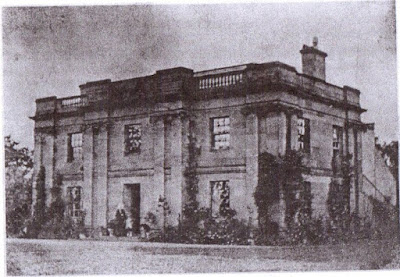 |
| Gourdihill House, Carse of Gowrie, Scotland. The building was demolished in 1989 because, before the New Data was discovered in 2014, none knew – due to Charles Darwin’s lies in 1860 – just how important and influential Matthew was in the discovery of natural selection. |
Perhaps a botanist can work it out now that it is newly re-discovered that John Matthew, at least according to the date on the letter he sent his father, used the name Wellingtonia to name the Sequoiadendron giganteum before Lindley received his seeds six months later and before Lindley first proposed that name six months later in the Gardener’s chronicle. Note that the Matthew letter (dated six months before Lindley’s article) was not published until six months after Lindley’s own article in which Lindley proposed the name Wellingtonia that Matthew had used six months earlier!
supplied by Patrick Matthew, that it is a myth that John Matthew himself brought the first giant redwood seeds into Britain and planted them. In reality, he sent them from California by ship to his father in Scotland:
 |
| Patrick Matthew and Christian Nicol were married in 1817 |
Timeline for what we do (currently) know
As “The Gardening Plot Thickens“: The focus of suspicion falls upon Lindley

Lindley was the Editor of the Gardener’s Chronicle on December 24th 1853 and was also editor on June 10th 1854. Lindley was not editor of the Gardener’s Chronicle in 1866, when the Matthew priority matter was settled, because he had died the year before!
Notably, Lindley was not Editor of the Gardener’s Chronicle in March 1860, when the correspondence of Matthew and Darwin proves Darwin committed lying plagiarizing science fraud of Matthew’s discovery of natural selection
Until the question of Lindley’s possible orchestration of ‘plagiarism by glory theft’ of John and Patrick Matthew’s priority for introducing the giant redwood into Britain is settled, the suspicion that his activities were, in some way, part of a solitary or group endeavour to deny Patrick Matthew’s glory for originating the hypothesis of natural selection – or in any other endeavour – cannot be ignored. However, I am not suggesting that there is evidence that we should be suspicious of some kind of conspiracy. Because, there is zero evidence for such a thing. Far more plausible, given the fact Matthew was not a part of the scientific community of gentlemen of science naturalists, and that his book broke all the rules and conventions of the 19th century gentlemen of science by way of hypothesising by deduction, weaving science in with politics, and reaching mocking, heretical and seditions conclusions based upon his observations and ideas (See Sutton 2014 for the full details), is that Lindley’s behaviour in this story can be hypothesised as occurring, in sociological theory terms (Cohen 2001), as part of an individual and, micro-cultural 19th-century gentleman of science, ‘synchronised state of denial‘ of the intrinsically obvious and significant facts.
Big questions, in need of further research:
Conservation/Sustainability Issues
Information from the website of the Royal Botanic gardens at Kew:
We see in John Matthew’s letter of 1853 that he was rather concerned about the destruction of the giant redwoods in california at that time. Other writers were far more outspoken about the destruction of these trees for exhibition display items. Public concern led to the establishment of the highly influential national parks service in the USA, which went on to inspire the world.
We can see below that at early as the time of John Matthew’s letter, others were unhappy about the destruction of the giant redwood trees/
From Gleason’s Pictorial Drawing Room companion (1853):
‘To our mind it seems a cruel idea, a perfect desecration, to cut down such a splendid tree. But this has not been done, however, without a vast deal of labor. It was accomplished by first boring holes through the body with long augers, worked by machinery, and afterward sawing from one to the other. Of course, as the sawing drew to a close, the workmen were on the alert to notice the first sign of toppling, but none came; the tree was so straight and evenly balanced on all sides that it retained its upright position after it had been sawed through. Wedges were then forced in, and a breeze happening to spring up, over went the monster with a crash that was heard for miles around. The bark was stripped from it for fifty feet from the base, and is from one to two feet in thickness. It was taken off in sections, so that it can be placed, relatively, in its original position, and thus give the beholder a just idea of the gigantic dimensions of the tree. So placed it will occupy a space of about thirty feet in diameter, or ninety feet in circumference, and fifty feet in height. A piece of the wood will be shown, which has been cut out from the tree across the whole diameter. We are told that this piece of wood shows a vestige of bark near the middle, and that this bark was evidently charred many centuries ago, when the tree was comparatively a sapling. At last accounts, the tree was in Stockton, on the way to San Francisco, where it was to be exhibited previous to its shipment to the Atlantic states. Probably it will not be very long, therefore, before our readers will be able to get a view of this monster of the California woods for a trifling admission fee. In Europe, such a natural production would have been cherished and protected, if necessary, by law; but in this money-making, go-ahead community, thirty or forty thousand dollars are paid for it, and the purchaser chops it down, and ships it off for a shilling show! We hope that no one will conceive the idea of purchasing Niagara Falls with the same purpose! The Mammoth Cave of Kentucky, is comparatively safe, being underground; and then it would be impossible to get it all the way through the limited size of the entrance! So, for the present, at least, we need not except the cave this way. But, seriously, what in the world could have possessed any mortal to embark in such a speculation with this mountain of wood? In its natural condition, rearing its majestic head towards heaven, and waving in all its native vigor, strength and verdure, it was a sight worth a pilgrimage to see; but now, alas! it is only a monument of the cupidity of those who have destroyed all there was of interest connected with it.’
The same bark- stripping process was used for the mock-up of the giant redwood used for exhibition at the Crystal Palace in Sydenham, England (The National Parks Service):
‘The skinning of the tree was utterly deplored by John Muir, who often set the tenor of feeling about such matters. In Muir’s words, this was “. . . as sensible a scheme as skinning our great men would be to prove their greatness” (Wolfe 1938). The display at Sydenham was immensely popular, however, and remained so until fire consumed both the Palace and the “Mother’s” vestments in 1866. With the tree’s removal from its ancient mountain home, hastened by many centuries, its value to mankind came to an untimely end.’
It is notable that John Matthew’s letter of 1853 describes a similar bark stripping act to supply a mock-up exhibit for the New York World’s Fair. It is even possible that the seeds he collected came from the tree felled in that same area that same summer that sparked the Conservation movement (The Guardian 2013):
‘On Monday, 27 June, 1853, a giant sequoia – one of the natural world’s most awe-inspiring sights – was brought to the ground by a band of gold-rush speculators in Calaveras county, California. It had taken the men three weeks to cut through the base of the 300ft-tall, 1,244-year-old tree, but finally it fell to the forest floor.’
 |
| Charles Darwin and Patrick Matthew |
For the want of the facts the celebrity was lost,
For the want of celebrity the truth was lost,
For the want of the truth, true history was lost,
For the want of true history true science was lost,
For the want of true science the world was lost,
And all for the want of the facts.
 |
| Images above and below: Original text from Gardeners Chronicle & New Horticulturist, 1866 Volume 26 pp. 1191-1192 |
Lindley must have had his ‘nose put out of joint’ by Matthew in the Gardener’s Chronicle in 1866. We can only assume he was unaware that Matthew had planted seeds in Britain six months before he received his own seed packet.
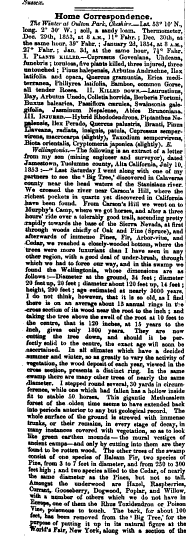 |
| Patrick Matthew’s provision of his son’s ‘priority proving’ John Matthew’s 1853 letter, published in 1854 on page 373, Vol 14 of the Gardener’s Chronicle |
Comments Off on A 19th Century ‘Garden Plot’ Thickens: Botanist John Lindley’s Somewhat Suspicious Involvement in a Failed Claim to Priority
The Comfort Zone
December 29th, 2015– By Mike Sutton –
On Christmas Eve, I commissioned my friend the Nottingham portrait artist Gabe Woods to paint an oil on canvas

picture of the metaphorical ‘comfort zone’.
I want this picture to use as a teaching device for the small minority of students who complain that we are making them think too hard. Honestly. I’m serious. This actually is a student complaint these days.
“Only when you leave your comfort zone,” I always inform such uncomfortably-brain-hurting students, “do you ever learn anything. Be glad, therefore, to be uncomfortable in your university education.”
Furthermore, I say:
“Would you otherwise wish to pay so much for what you already know – or could find out without our expert help? We are here not so much to impart knowledge – but to help you think. And good thinking – ‘best thinking’ is uncomfortable.”
Gabe and I discussed some ideas as to how he might fulfil this brief. I’ve no idea what we are going to end up with. I want it to be something students can be asked to go and pay a visit to. Something they will stand before, contemplate and be – hopefully – moved and inspired by.
Meanwhile, I decided to use the BigData-IDD method to find the origins of the term.
At the time of writing (28.December, 2015) the shameless plagiarizing editors of the unreliable so-called encyclopedia Wikipedia have no idea when the term was first coined.
I discovered that once again I can get back further than the etymological experts with my BigDada-IDD technique. For example, the best selling etymologist David Wilton writes :
‘comfort zone, n. When introduced in 1923, this term referred to home heating. It wasn’t until the 1970s that the phrase began to be applied metaphorically.’
Wilton is right about the built environment heating origins. But the term occurred in print at least a decade earlier than his best efforts could detect – in the ‘Heating and Ventilating Magazine’ Building Systems Design, Volume 10, (1913) on page 30:
ESTABLISHMENT OF A COMFORT ZONE. Before working very long, it became evident that there was a temperature and humidity range within which the occupants of the rooms were comfortable.
In my opinion, far more interesting, however, is that the extremely rare phrase ‘comfort’s zone’ occurred first, and once only, in a poem of 1819. In ‘Aonian Hours and other Poems’ by W. H. Wiffen:
Oxford Dictionaries online has a good explanation of the concept of the comfort zone metaphor:
(a) A situation where one feels safe or at ease or settled. (b) Method of working that requires little effort and yields only barely acceptable results: if you stay within your comfort zone you will never improve.’
An interesting publication on the metaphor of the comfort zone
Comments Off on The Comfort Zone
The Royal Society Darwin Medal Scandal: You won’t win a Darwin Medal for writing the truth about the discovery of natural selection
December 12th, 2015– By Mike Sutton –
It is universally accepted by leading evolutionary biologists that Patrick Matthew was first to go into print with the full and detailed hypothesis of natural selection almost three decades before Wallace and Darwin repeated the same ideas and explanatory examples but failed to cite the originator even though his greatest influencer Blyth had his work edited by a famous naturalist (Loudon) who cited Matthew’s original ideas in 1832. Wallace’s (1855) Sarawak paper was edited by Selby, another who read and cited Matthew’s ideas. And Robert Chambers – who influenced both Darwin and Wallace on evolution – cited Matthew’s book before writing the Vestiges of Creation (see Sutton 2015) .
In an earlier blog, I revealed that the Royal Society Darwin Medal winners Sir Gavin de Beer and Ernst Mayr both published the nonsense-on-stilts that Matthew’s ideas were not read by any naturalists of biologists before 1860 – a year after Darwin replicated the in the Origin of Species (See my blog post of 26th August 2015 for the hard facts). (See my blog post of 26th August 2015 for the hard facts).
In this blog post, I reveal the totally fallacious Darwin deification claptrap on this topic published by a third Royal Society Darwin Medal Winner – his name is William D. Hamilton.
Narrow Roads of Gene Land : The Collected Papers of W. D. Hamilton Volume 2: Evolution of Sex: Evolution of Sex Vol 2 (Evolution of Sex, 2) – page 211:
‘Darwin, not Patrick Matthew gets the full credit for evolution by natural selection because Darwin wrote his ideas clearly and persistently with extreme multiplicity of illustrations, not a few paragraphs (clear though those paragraphs also were) of note F of an appendix to a book on naval timber and arboriculture.’
Hamilton’s biased fallacy spreading confirms the proposition that Royal Society Darwin Medals are not given out to those who write the truth. It seems they are earned by those who write easily discoverable falsehoods to prop up the reputation of the Royal Society’s science royalty darling Charles Darwin at the glory theft expense of the truth that Matthew should be considered the originator and most eminent author on the topic of natural selection.
As Matthew’s 1860 letters to Darwin in the Gardener’a Chronicle – and even a cursory examination of his book – prove Matthew’s ideas were spread throughout his 1831 book and not just concentrated in its Appendix. In disconfirmation of the Darwinist myth, propagated by Darwin (1861) from the third edition onwards of the Origin of Species, that Matthew merely enunciated natural selection in the appendix of his book, it is in fact in the main body of his book where Matthew used facts about varieties bred by means of artificial selection as a way to demonstrate how differently nature worked to mankind, because natural selection results in fewer but more robust varieties.
The following texts represent just three examples among many others that could be used to prove just how completely fallacious was Hamilton’s (1998) claim that Matthew’s ideas were brief, unclear, and solely in note F of the appendix of his book: For example, in the main body of his book, he wrote (Matthew 1831)
Matthew (1831 Page 67):
‘Our common larch like almost every other kind of tree consists of numberless varieties, which differ considerably in quickness of growth, ultimate size, and value of timber. This subject has been much neglected. We are, however, on the eve of great improvements in arboriculture; the qualities and habits of varieties are just beginning to be studied. It is also found that the uniformity in each kind of wild growing plants called species may be broken down by art or culture and that when once a breach is made, there is almost no limit to disorder, the mele that ensues being nearly incapable of reduction.’
Matthew, 1831 Page 76):
‘The consequences are now being developed of our deplorable ignorance of, or inattention to, one of the most evident traits of natural history, that vegetables as well as animals are generally liable to an almost unlimited diversification, regulated by climate[1], soil, nourishment, and new commixture of already formed varieties. In those with which man is most intimate, and where his agency in throwing them from their natural locality and dispositions has brought out this power of diversification in stronger shades, it has been forced upon his notice, as in man himself in the dog, horse, cow, sheep, poultry.- in the apple, Pear, plum, gooseberry, potato, pea, which sport in infinite varieties, differing considerably in size, colour, taste, firmness of texture, period of growth, almost in every recognisable quality. In all these kinds man is influential in preventing deterioration, by careful selection of the largest or most valuable as breeders; but in timber trees the opposite course has been pursued. The large growing varieties being so long of coming to produce seed, that many plantations are cut down before they reach this maturity, the small growing and weakly varieties, known by early and extreme seeding, have been continually selected as reproductive stock, from the ease and conveniency with which their seed could be procured; and the husks of several kinds of these invariably kiln dried, in order that the seeds might be the more easily extracted! May we then wonder that our plantations are occupied by a sickly short lived puny race, incapable of supporting existence in situations where their own kind had formerly flourished – particularly evinced in the genus Pinus more particularly in the species Scots fir; so much inferior to those of Nature’s own rearing, where only the stronger, more hardy soil, suited varieties can struggle forward to maturity and reproduction?
We say that the rural economist should pay as much regard to the breed or particular variety of his forest trees, as he does to that of his live stock of horses, cows, and sheep. That nurserymen should attest the variety of their timber plants, sowing no seeds but those gathered from the largest, most healthy, and luxuriant growing trees, abstaining from the seed of the prematurely productive, and also from that of the very aged and over mature; as they, from animal analogy, may be expected to give an infirm progeny, subject to premature decay.’
Matthew (1831, p. 308):
‘Man’s interference, by preventing this natural process of selection among plants, independent of the wider range of circumstances to which he introduces them, has increased the differences in varieties particularly in the more domesticated kinds…’
Comments Off on The Royal Society Darwin Medal Scandal: You won’t win a Darwin Medal for writing the truth about the discovery of natural selection
On Darwinism versus Darwinist
November 22nd, 2015– Mike Sutton –
ONCE AGAIN, THE BIGDATA-IDD METHOD CUTS THROUGH UNINFORMED CLAPTRAP LIKE A BUZZSAW IN BALONEY
Vogt (1863) was apparently the first to be second to use the term Darwinist, which was first coined in 1861
I’ve noticed, since the publication of my myth busting book Nullius in Verba: Darwin’s greatest secret, that many commentators really don’t like being referred to as Darwinists, although they have no problem with ‘Darwinism’. Many Darwinists consider the word ‘Darwinist’ as a term of abuse, and they attribute it to irrational arguments made against Darwin and the theory of natural selection. On which note, according to Jonathan Wells, of the “intelligent design” community, the terms ‘Darwinism’ and Darwinist’ are interchangeable and Darwinists are wrong to believe the term ‘Darwinist’ is meant to be derogatory.
Darwinist or Darwinian, They’re One and the Same by Jonathan Wells August 31, 2007:
Could Scott be following the lead of Harvard sociobiologist Edward O. Wilson, who claims that the word “Darwinism” was coined by creationists to make Darwin look bad? “It’s a rhetorical device to make evolution seem like a kind of faith, like ‘Maoism’,” said Wilson in Newsweek in November 2005. “Scientists,” he added, “don’t call it Darwinism.”
Nice try, but Wilson’s revisionist approach to the history of biology doesn’t fit the facts. According to the Oxford English Dictionary, Thomas Henry Huxley (Darwin’s most famous defender in Britain) used “Darwinism” in 1864 to describe Charles Darwin’s theory. In 1876, Harvard botanist Asa Gray (who was Darwin’s most ardent scientific defender in America) published Darwiniana: Essays and Reviews Pertaining to Darwinism, and in 1889 natural selection’s co-discoverer Alfred Russel Wallace published Darwinism: An Exposition of the Theory of Natural Selection. Two of Wilson’s former Harvard colleagues, evolutionary biologists Ernst Mayr and Stephen Jay Gould, used the word extensively in their scientific writings, and recent science journals carry articles with titles such as “Darwinism and Immunology” and “The Integration of Darwinism and Evolutionary Morphology.”
The reason that “Darwinism” and “Darwinian” — even “Darwinist” — are used by modern evolutionary biologists is that they are more precise than “evolution” and “evolutionist.” The latter have many meanings, most of them uncontroversial.
The OED has detected the use of the word Darwinism to refer to either the poetry of Darwin’s grandfather Erasmus Darwin, or else, presumably, Erasmus’s belief in the development theory of evolution (that all things are evolving to perfection – which is not natural selection theory). Here the first usage discovered by the OED is 1840:
.1840 Brit. & Foreign Rev. 10 105 The blank verse of Queen Mab differs little from that measure as it appears in the poems of Akenside, who exercised considerable influence over such poets as escaped from the popular vortex of Darwinism.’
And at the time of writing, the OED has the use of the modern meaning of the term Darwinism dated to Darwin’s friend Thomas Huxley (AKA Darwin’s Bulldog), who was apparently first to use the word Darwinism in this regard in 1860. Huxley used the word in his 1860 book review (published in the Westminster Review) of Darwin’s Origin of Species published in the Westminster Review, (see Darwin Online):
Huxley was apparently the first to coin the word “Darwinism” in 1860
And so we see that the OED is today accurate, if not when Wells wrote on the topic in 2007, with regards to the earliest discoverable use of the word Darwinism. Moreover, here Wells is right, because the term most certainly was not coined in a derogatory context for either Erasmus or Charles. .
So what of the Etymological Origins of the term Darwinist?
The Oxford English Dictionary OED (at the time of writing 23.11.15) has it that it means one or both of two things::
A follower of Charles Darwin; a person who accepts or promotes Darwinism (in scientific and extended use).
And the earliest date the so-called etymological “experts” at the OED can get back to for the word is:
“1864 J. Hunt tr. C. Vogt Lect. on Man xvi. 464 No Darwinist [Ger. Darwinist],” ” if we must call them so, has either raised that question or drawn the above inference.”
Once again BIgData-IDD gets us back further than the OED’s experts
When it comes to the term Darwinist – no matter how it is used and perceived by different people today – the same BigData-DD method that found the data that re-wrote the history of the discovery of natural selection (Sutton 2014 ) allows us to uncover the fact that ‘Darwinist’ was, apparently, first coined – in 1861 in a Dutch Book entitled “The Agony of the Popes” by Edmond Lafond, and Adrianus J. Bemmel. Here the context is somewhat supportive of Darwinism.
First coining of the word Darwinist by Edmond Lafond, and Adrianus J. Bemmel in 1861
As we can see in the image of the text below, where Vogt is quoted by James Hunt (1866), who two years earlier edited Vogt’s 1864 book, which is simply the English translation of Vogt’s 1863 original German version, the term Darwinist was used by Vogt in what is a fairly derogatory way. The term is used also, seemingly, in a rather begrudgingly way by Vogt, who seems reluctant to comply with using the prior-published group identifying label for Darwin’s faithful followers. See Vogt in 1864 in English and in 1863 in the original German. Perhaps this is because the German Vogt was not at all happy at the idea of natural selection. He certainly disliked its natural conclusions regarding the divergent ramifications of life, since they undermined his beliefs about species.
Vogt in 1863 was, apparently, “first to be second” in a German publication with the term Darwinist.
Natural selection was first explained by Patrick Matthew (1831) in his first book ‘On Naval Timber and Arboriculture’ where he explained the origin of species being defined as those that ramified from but could no longer breed with a common ancestor, meant there were no different species of human beings – only different varieties. But Carl Vogt believed – contrary to the sound knowledge of Thomas Huxley on this topic – that Black people and White people are distinct species. Of course, Matthew knew the very same thing that Huxley later concluded as early as 1831 when he first published his original ideas on ‘the natural process of selection’.
Thanks to Big Data analysis of the literature comprising the books scanned in the Google Library Project, we now know that – contrary to the beliefs of many Darwinists – the term used to name them was apparently originally penned in a book written in Dutch in 1861, where it was first coined in print as a compliment.
Matthew took the original ideas of 1831 forward in his second book ‘Emigration Fields’ (Matthew 1839) where he recommended white British colonists interbreed with the Maori people of New Zealand and was apparently first to coin both the phrase and concept of the modern Peace Corps (here) .
See PatrickMatthew.com for the full details of Darwin’s and Wallace’s plagiarism and the dreadful ‘culture of concealment’ dysology of Darwin’s Darwinists on the topic since 1860 to the present day.
Comments Off on On Darwinism versus Darwinist
Thanksgiving: the English Origins of the Word and American Holiday
November 8th, 2015By Mike Sutton
The website of the History Channel – History.com provides a neat summary of the history of the first American 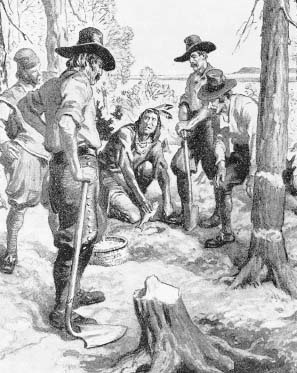 Thanksgiving in the Plymouth settlement in America, which is marked as the year following the first 1620 settlement of those who sailed from Plymouth, England, to what they then, unimaginatively, named Plymouth – in America – where they settled:
Thanksgiving in the Plymouth settlement in America, which is marked as the year following the first 1620 settlement of those who sailed from Plymouth, England, to what they then, unimaginatively, named Plymouth – in America – where they settled:
‘In November 1621, after the Pilgrims’ first corn harvest proved successful, Governor Wiliam Bradford organized a celebratory feast andinvited a group of the fledgling colony’s Native American allies, including the Wampanoag chief Massasoit. Now remembered as American’s “first Thanksgiving”—although the Pilgrims themselves may not have used the term at the time—.
THANKSGIVING the BigData-ID SUPERIOR ETYMOLOGY
Whilst Americans get together on the fourth Thursday in November every year for the sensational celebrations, the word Thanksgiving (and the term thanks giving) had been used regularly back in England and Scotland to name officially days of Christian religious celebration – usually in thanks for some kind of peace following military victory.Thanksgiving days were, therefore, a tradition brought over to the American colonies from England and Scotland.
The BigData-ID Method (See the freely available Chapter Two in my book: Nullius in Verba Darwin’s greatest Secret) , once again, just as it does in the case of theEaster Bunny, Halloween and Guy Fawkes Night, beats the Oxford English Dictionary and all other etymological sources to reveal the apparent first English-language use of the term thanksgiving day, as well as its apparent first use to refer to the American celebration – but not the one in Plymouth.
The Plymouth Brethren were far from being first with a Thanksgiving day in America.
There are in fact many contested cases in the USA for far earlier Thanksgiving days (see Coleman 2015) . For example, see the 1622 publication of Virginia’s Thanksgiving sermon of 1616. Coleman’s excellent evidence-led book explains that only a dreadfully poor historian would claim that the origin of the term ‘thanksgiving day’ or even the origin of the concept of the American holiday to celebrate it has its roots in Plymouth, Massachusetts, in 1621. The only reason so many American’s have been fooled is because long powerful and dominant interest groups in America came from that region.
One again BigData-ID English Etymology beats the Oxford English Dictionary into a cocked hat!
The term “thanks giving” –
“Thanks giving” – England 1618
The term “thanksgiving day”
“Thanks-giving day”– Apparently first published use in England 1648 and 1654 for Thanksgiving day .
Thanksgiving day used in 1663 as a designated national celebratory day to mark a period of peace following civil conflict – England 1662 and also England 1663
Thanksgiving day 18th September Oliver Cromwell got Parliament to create a Thanksgiving day for a victory over the Scottish – England 1675
THE OED
Here is the best effort of inferior etymology provided by the Oxford English Dictionary (OED) in what it publishes, at the time of writing – (8th November 2015) as the earliest attested publication of thanksgiving day.
Comments Off on Thanksgiving: the English Origins of the Word and American Holiday
The 300 year Old Etymological Evolution of Gunpowder Treason Day
November 1st, 2015– By Mike Sutton –
Whereas the ID method gets us back as far as 1811 (see my timeline, below and Appendix 1), The Oxford English Dictionary (OED) can get back only as far as 1826 for the first published use of “Guy Fawkes Day:
“1825 W. Hone Every-day Bk. (1826) I. 1430/2 ‘Guy Fawkes-day’, or, as they as often call it, ‘Pope-day’, is a holiday, and.., on account of its festivous enjoyment, is the greatest holiday of the season.”
Worse, the OED can get back no further than 1936 for the term ‘Bonfire Night’, whereas the ID method gets us as far back as 1705 (See my timeline below and evidence in Appendix 1).
From the OED:
“1936 N. Smith 52 Yrs. at Labrador Fishery 114 We opened the Club on Bonfire Night, November 5th.”
‘Guy: an effigy of Guy Fawkes burned on a bonfire every 5th November to commemorate his part in the gunpowder plot, an attempt to blow up King James 1st and parliament in 1605. Fawkes was executed and the name ‘guy’ was being applied to such an effigy by the early 19th century at least. From thence, the word was applied to any disreputable person, and thence – particularly in the US from the 1890’s – to any man, good as well as bad.’
Timeline (in date order) of the ‘at the time of writing’ earliest discoverable use of Guy Fawkes Night, November 5th, names:
Using my original Big Data ID research method (Sutton 2014 ), today (1st November 2015) I conducted the first ever fully dated November 5th etymology of the origins of different names for Guy Fawkes Day.The dates listed in the timeline in this blog post represent the first usage of these names that can be found today amongst the 35+ million books in Google’s Library project. No doubt, as more books are scanned, these dates may one day be superseded by new discoveries of earlier usage. For now, however, these dates give us the first ever precise pinpointing of first known useage of various names for Guy Fawkes Day:
Further original discoveries made with the ID method can be found in my A-Z of newly busted myths in Nullius in Verba: Darwin’s Greatest Secret (that chapter is free for you to to view at Amazon books at absolutely no cost whatsoever).
The ID facilitated Etymology of the Easter Bunny (here)The ID facilitated Etymology of Halloween (here)
APPENDIX 1
Published evidence for the Full Etymology of Guy Fawkes Night (in no particular order)
Comments Off on The 300 year Old Etymological Evolution of Gunpowder Treason Day
Happy Halloween: Amazingly, it Appears that the Scottish Poet Robert Burns Coined the Word
October 31st, 2015– By Mike Sutton –

Today (31 October 2015) is Halloween. And so, from that cause, I deployed my Big Data ID method – which is, incidentally, the same method – see Sutton 2014 – that debunked Charles Darwin’s self-serving lie that no naturalist had read Scottish horticulturist Patrick Matthew’s (1831) prior published full hypothesis of ‘the natural process of selection’ before he replicated it 27 years later – to discover the first published use of the word Halloween.
The powerful ID method enabled me to discover that what appears to be the earliest currently known printed origin of the word ‘Halloween’ – or more precisely ‘Hallow E’en’ – is 1724. Moreover, the Scottish poet Robert Burns appears to have been first into print in 1786 with the more modern appearance of the word Halloween from the poem he penned of that name in 1785.
Prior knowledge
At the time of writing, Wikipedia and seemingly countless other websites vaguely have it that the earliest known usage of the word is “about 1745”. The Online Etymology Dictionary makes the same conveniently vague claim, as does the mighty Chambers’ Dictionary of Etymology.
Incidentally, the same Big Data ID method uniquely discovered that its founder Robert Chambers, author of the Vestiges of Creation, correspondent and associate of Darwin, had earlier read and then cited Matthew’s (1831) book in 1832 (see Sutton 2104a ) With regard to the origin of the word Halloween, Chambers Dictionary of Etymology (2012 p 462) has it:
‘Halloween or Hallowe’en about 1745, Scottish shortening of Allhallow-even’.
More precisely, the ID method enables us to get back two decades earlier than Chambers to pinpoint the first – to date – discoverable use of the word ‘Hallow E’en’ to be 1724. on page 22 of a book by Alan Ramsay entitled The Teatime Miscellany:
Curiously we see from Ramsay’s prose that there appears to have been an apparently well-known tune of the same name. Further research reveals this song was published n 1726. (More on Ramsay himself: here ).
In 1786 we find what to date appears to be the earliest discoverable use of the unhyphenated word Halloween and it is by none other than the great Scottish poet: Robert Burns (pp 101-102 ) who famously penned it in ink the year before.
The trusty ID method strikes once again!
For more examples of the power of the new research method, check out the free to view Chapter Three in Nullius In Verba: Darwin’s greatest secret at Amazon books – which contains my A-Z of originally busted myths.
If you want to know the real origin of the Easter Bunnie? Here it is.
Comments Off on Happy Halloween: Amazingly, it Appears that the Scottish Poet Robert Burns Coined the Word




